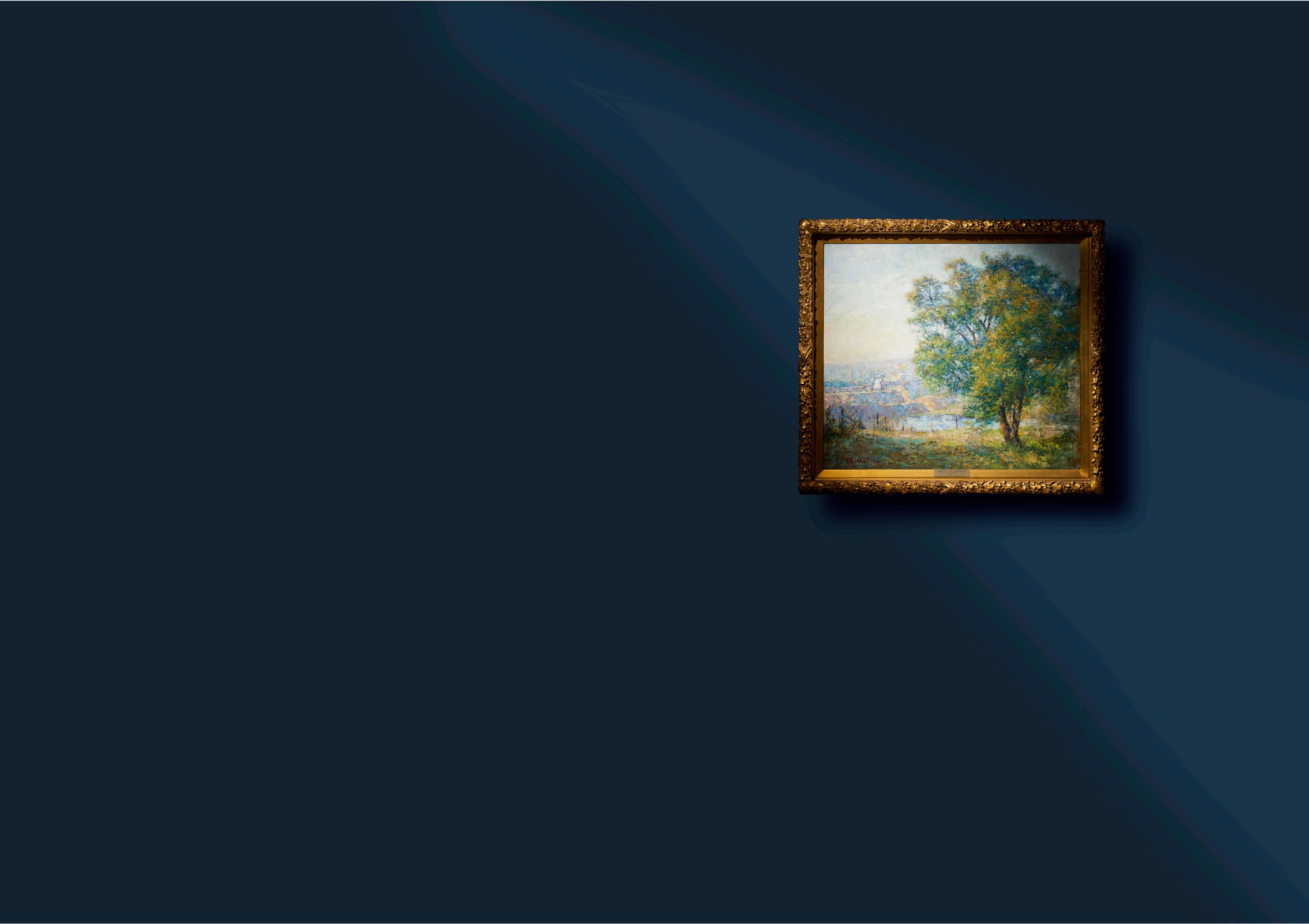

A Private Collection of Important Australian Art
25.08.2025, 6pm
VIEWINGS
viewing in sydney thu 14 – sun 17 aug The Bond, 36-40 Queen Street, Woollahra, NSW 2025
viewing in melbourne thu 21 – sun 24 aug 2 Oxley Road, Hawthorn, VIC 3122
Please refer to our website for viewing times — leonardjoel.com.au
CONTACTS
wiebke brix
head of art
03 8825 5624
wiebke.brix@ leonardjoel.com.au
amanda north senior art specialist 03 8825 5644 amanda.north@ leonardjoel.com.au
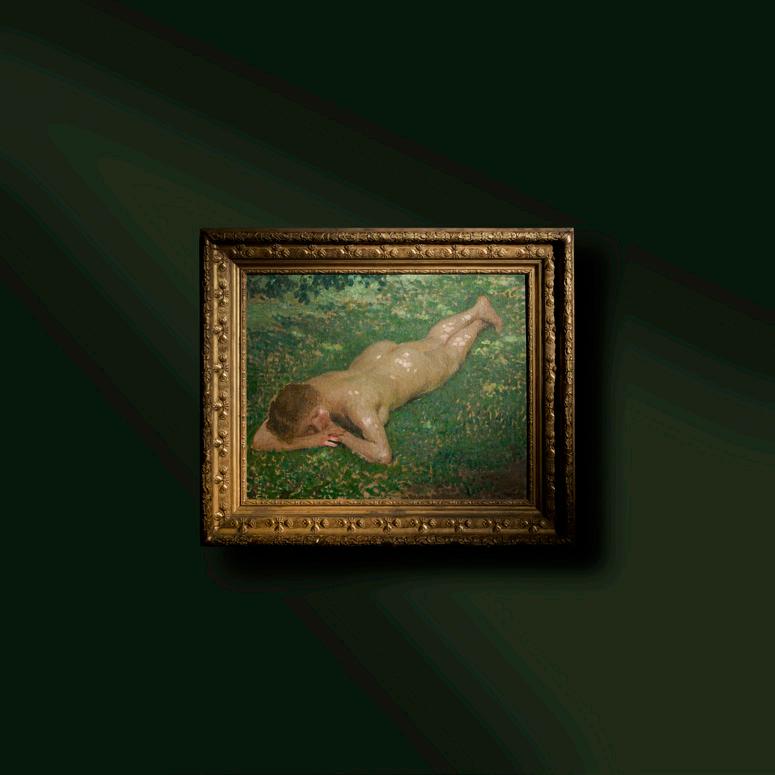
50 x 75cm

FREDERICK MCCUBBIN (1855-1917) Hammersmith Bridge c.1907
24 x 33.5cm
$25,000-35,000 lot 2
EMANUEL PHILLIPS FOX (1865-1915) (Port Phillip, Melbourne) c.1908
25 x 33cm
$30,000-40,000

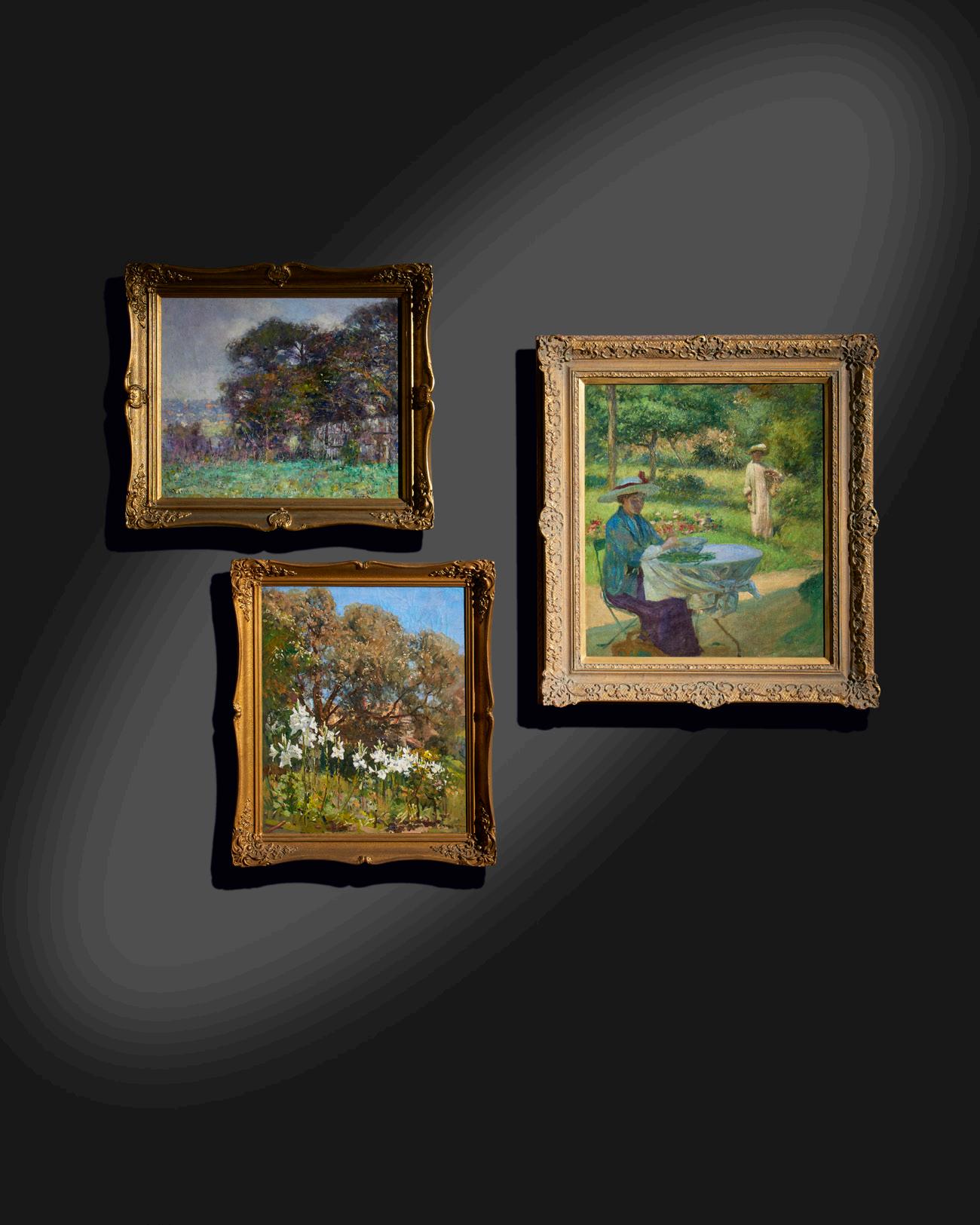
A Private Collection of Important Australian Art
It is both a privilege and a pleasure to present this exceptional private collection of Australian art at Leonard Joel. Comprising thirty-three works by some of the most important Australian painters of the late nineteenth and early twentieth centuries. These include Frederick McCubbin, Rupert Bunny, Emanuel Phillips Fox, Tom Roberts, and Arthur Streeton. The collection offers an opportunity to engage with Australian Impressionism, a defining moment in our art history. Assembled quietly and with great discernment over many decades, the collection reflects not only the eye of its private collector but also a deep appreciation for a significant era. These are not just beautiful paintings, they are historical records. Each work bears witness to a certain period in time through the eyes of artists who interpreted the Australian experience with a modern sensibility. Inspired by the global art movement of their time, these artists were instrumental in shaping how Australians would come to see themselves.
Impressionism first emerged in France in the late 19th century, born out of a desire to capture fleeting effects of light, atmosphere, and modern life. Artists such as Claude Monet, Pierre-Auguste Renoir and Camille Pissarro abandoned academic conventions in favour of direct visual engagement with their surroundings, often painting outdoors to capture transient shifts in light. Their first group exhibition in 1874 introduced the term “Impressionism,” derived from Monet's painting Impression, Soleil Levant. As John House writes, “Impressionism aimed to depict the modern world with spontaneity and truthfulness, rejecting conventional idealism in favour of a direct encounter with the visual world.”1
In Australia, a parallel yet unique movement emerged, known today as the Heidelberg School. Artists represented in this sale including Frederick McCubbin, Tom Roberts, Arthur Streeton and Charles Conder adapted Impressionist methods, embracing plein air techniques to respond to the dry light, ochre tones, and vast spaces of the Australian bush. As Ian Burn observed, “The Heidelberg School attempted to represent an Australia seen and felt firsthand, rather than imagined through the lens of Europe.”2
clockwise: lot 13
FREDERICK MCCUBBIN (1855-1917)
The Artist’s Garden, South Yarra oil on canvas
49.5 x 59.5cm
$80,000-120,000
lot 4
RUPERT BUNNY
(1864-1947)
Two Women in a Garden c.1912 oil on canvas laid on masonite
67 x 58cm
$70,000-100,000
lot 3
ARTHUR STREETON (1867-1943)
Madonnas in a Garden c.1935
(also known as Olive Trees and Lillies)
oil on canvas
60 x 50cm
$60,000-70,000
It is this very movement that speaks through this collection and the significance and importance of the works is evident. At the heart of the collection is our cover lot The Lime Tree (Yarra River from Kensington Road, South Yarra) (Lot 10), painted in 1917 by Frederick McCubbin, the final work by the artist before his death. Painted from the garden of his South Yarra home and depicting the beautiful tree that shaded his view towards the Yarra River. As Dr Christopher Heathcote writes in his contribution to this catalogue, “Much is packed into this composition… a glimpse of the Yarra River and suburban Richmond beyond, as well as the artist’s signature paintwork.” The painting’s intimate scale and atmospheric brushwork speak to McCubbin’s late style, a luminous evocation of nature that prioritised feeling over narrative. The provenance of the painting, passing directly from McCubbin’s wife to key early collectors, and its rich exhibition history, including showings at the National Gallery of Victoria, Melbourne and the National Gallery of Australia, Canberra further illustrate its historical significance. Dr Catherine Speck highlights in her essay on Rupert Bunny The Sonata (Lot 17), painted circa 1911 and first exhibited in Melbourne before being shown at the Société Nationale des Beaux-Arts in Lyon. Two female figures sit together enjoying music, bathed in soft light. The painting is a masterclass in tone and composition. It belongs to a series of works from Bunny’s Paris years in which musical and literary allusions served as vehicles for exploring femininity and modern life. The Sonata is part of the same series as Une Nuit de Canicule, a landmark painting that was the first Australian artwork to ever exceed one million dollars at auction, sold at Leonard Joel in 1988. A testament to Bunny’s enduring appeal and place in art market history. Une Nuit de Canicule was tragically lost in a fire, but Sonata continues to share the mood and palette of the Belle Époque.
The collection also includes Nu En Plein Air (Lot 11) by E. Phillips Fox, painted around 1911 in the private garden of the artist’s Paris apartment. The model reclines in a patch of dappled light, rendered with a freshness and immediacy that illustrates Fox’s plein air virtuosity. Angela Goddard, in her catalogue essay, describes the technical brilliance of the work: “In the privacy of the garden of the Foxes' Boulevard Arago apartment in Paris, this flame-haired sensuous nude (one of many red-haired models preferred by Fox, which included the Australian artist Edith Susan Gerard Anderson) lounges diagonally across a bed of bright green, lightflecked grass, with Fox leaving areas of the light brown bare canvas to aid the delicate effect.” The result is a remarkable example of the play with light that is so inherent to Impressionism.
Arthur Streeton is another cornerstone of this collection, and his presence serves as a bridge between the lyrical optimism of the Heidelberg School and the heroic vision of Federation-era Australia. Dr Suzannah Henty traces Streeton’s development from the artists’ camps at Eaglemont to his majestic coastal vistas and late garden scenes. His gift, as she notes, was in capturing the fleeting quality of light and atmosphere, whether on the plains of Heidelberg, the cliffs of Port Campbell, or the flowerbeds of his Toorak garden. Works in this sale show Streeton’s shift from youthful experimentation to mature mastery.
Tom Roberts is represented in the collection through a landscape and two rare and moving portraits from his London years. Dr Julie Cotter’s essay explores Roberts’s deep engagement with costume, character, and society, particularly through his portrayal of Lady Coghlan (Lot 12) and Violet Bancroft (Lot 27). These works speak not only to Roberts’s technical refinement but to his interest in the character of his sitters. Lady Coghlan, in her black fur-trimmed coat and veiled hat, embodies a modern woman. This work is presented in a sought-after frame by Robert’s wife Lillie Williamson. Violet Bancroft, by contrast, is a portrait of quiet resilience, elegantly dressed, but bearing the emotional weight of family tragedy. Both paintings are compassionate studies of identity and modern femininity.
The works highlighted in this foreword represent only a small selection from a remarkable group of thirty-three paintings, with each piece in the collection contributing to a broader understanding of art and its enduring resonance.
We warmly invite you to experience these works in person during our public viewings in Sydney or Melbourne.
wiebke brix head of art
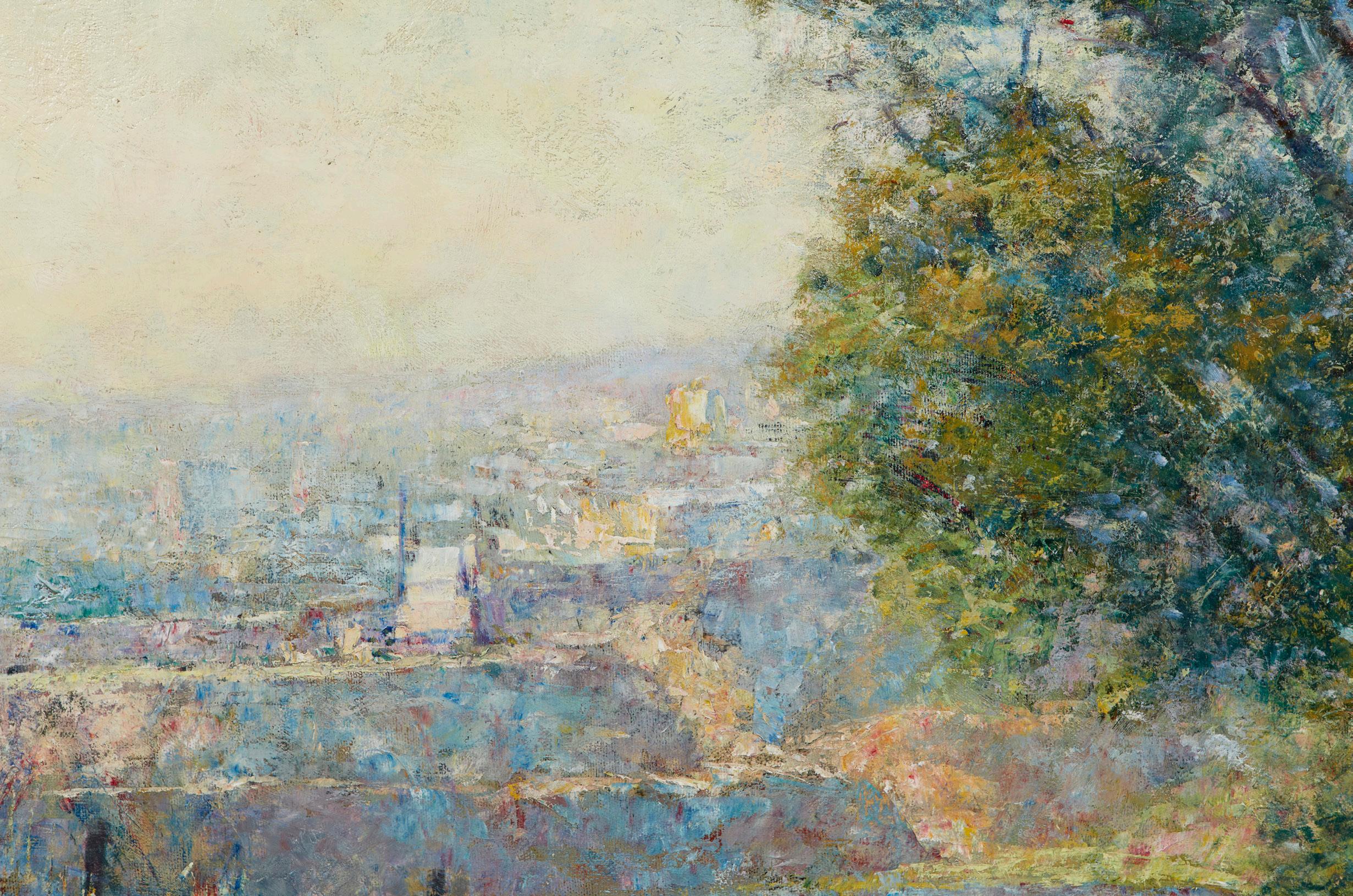

1
FLORENCE FULLER (1867-1946)
Fleury Road in Spring c.1896 oil on board
signed lower right: F A Fuller inscribed on unknown label affixed verso: Fleury Rd in Spring/ £8-8-0/ Florence Fuller 38 x 22cm
provenance
(possibly) Victorian Artists’ Society, Melbourne Christies, Melbourne, 27 November 2000, lot 331 (as “Country Path”)
The Collection of Kurt Albrecht, Melbourne
Thence by descent
Kozminsky Galleries, Melbourne (as “Country Path”) Private collection, Western Australia
exhibitions
(possibly) Victorian Artists’ Society, Melbourne, October 1896, cat. no. 2
Through Women’s Eyes: An Exhibition of Works by Eight Prominent Women Artists who attended PLC Melbourne between 1880 and 1946 and who made a Significant Contribution to the Development of Art in Australia, Glen Eira City Council Gallery, Caulfield, 14 February - 18 March 2001 (as “Country Path”)
literature
(possibly) Art Exhibition: Victorian Artists’ Society, The Age, 24 October 1896, p. 11
“...Miss Fuller has gained much in technical knowledge and in the simplicity and refinement of her colour. She sends an open air study of a child’s head, a French village scene exhibited at the Salon, and a delightful little painting of a narrow village road running between high grey walls surmounted by trees just breaking into leaf and blossom under a delicate vaporous sky.”
$6,000-9,000


2
EMANUEL PHILLIPS FOX (1865-1915) (Port Phillip, Melbourne) c.1908 oil on panel
signed lower right: E. Phillips Fox
inscribed verso: Phillips Fox/ 21/10/97/ Port Phillip/ BEQUEST/ TO/ NORMA HUNT./ 1982. (concealed)
artist’s name and title on gallery label affixed verso 25 x 33cm
provenance
The Collection of Ralph Smith, Sydney
Thence by descent
Gowrie Galleries, Sydney (label verso)
Private collection, Sydney Christies, Sydney, 14 August 1994, lot 54
Private collection, Sydney Christies, Melbourne, 27 November 2000, lot 103
Private collection, Western Australia
literature
Zubans, R., E. Phillips Fox, His Life and Art, Miegunyah Press, Melbourne University, Melbourne, 1995, pp. 134 (illus.), 224, cat. no. 298, pl. C42
$30,000-40,000

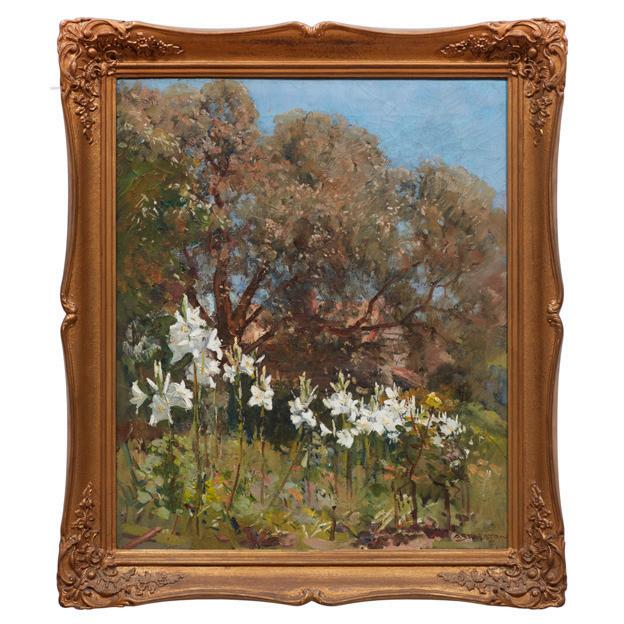
3
ARTHUR STREETON (1867-1943)
Madonnas in a Garden c.1935
(also known as Olive Trees and Lillies)
oil on canvas in original John Thallon frame (label verso) signed lower right: A STREETON
60 x 50cm
provenance
Athenaeum Gallery, Melbourne
Private collection, Melbourne, acquired from the above in 1943
Thence by descent
Leonard Joel, Melbourne, 21 September 2001, lot 200
Private collection, Western Australia
exhibitions
Exhibition of Oil Paintings by Arthur Streeton: Landscapes and Flowers, Athenaeum Gallery, Melbourne, June 1935, cat. no. 18
Exhibition of Paintings by Sir Arthur Streeton, Athenaeum Gallery, Melbourne, 11 - 23 January 1943, cat. no. 33 (as “Olive Trees and Lillies”)
literature
Arthur Streeton and his Magic Brush, The Herald, Melbourne, 10 June 1935, p. 8
Arthur Streeton Great Painter of Australia, Brilliant Flower Pieces, The Argus, Melbourne, 11 June 1935, p. 7
“...The certainty with which Streeton sets down brush strokes, full brisk, correct in tone and colour, is amazing. The whole show at the Athenaeum Gallery is an object lesson to students and to painter’s illusions of light are finely painted particularly in no. 7 “Lilies and Bells”, and in no. 18, “Madonnas in a Garden”. Both are studies of Christmas lilies painted out of doors growing in a flower bed.”
related work
Arthur Streeton, Olinda 1935, oil on canvas, 64.2 x 102cm, Private collection, Smith, G., Arthur Streeton 1867-1943, National Gallery of Victoria, Melbourne, p. 182-83, cat. no. 78 (illus.)
$60,000-70,000
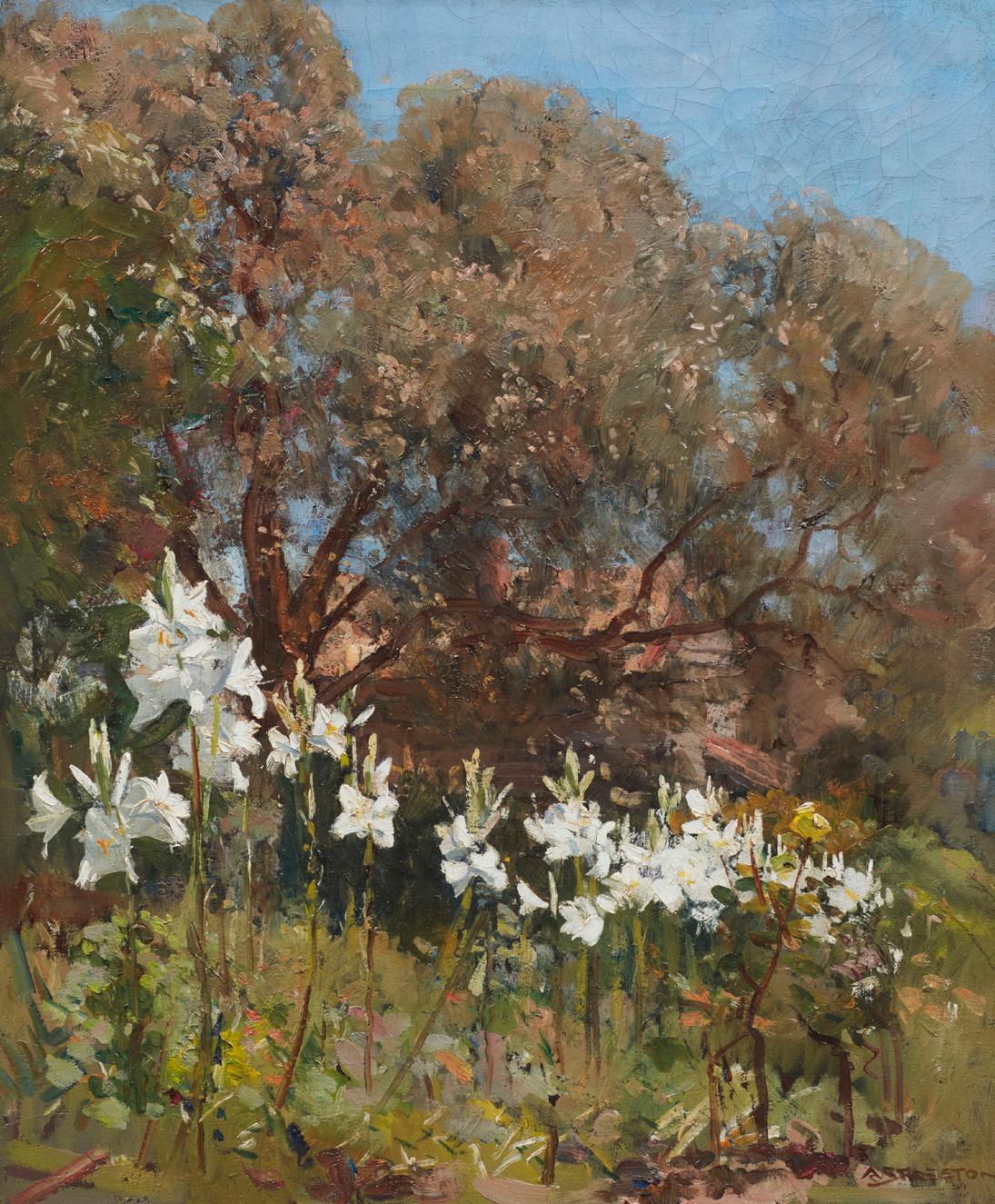
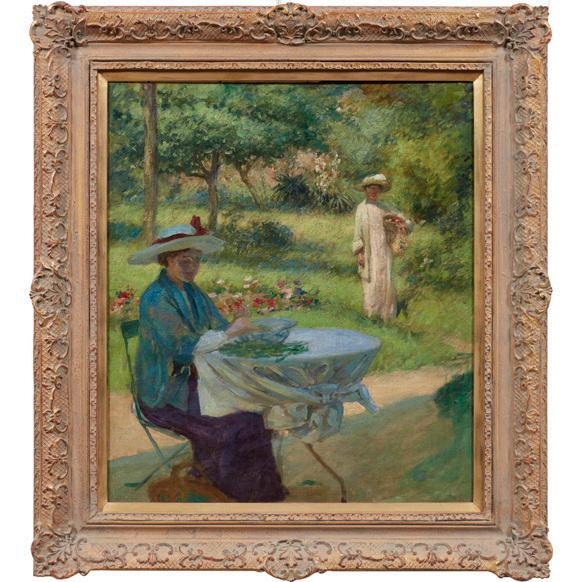
4
RUPERT BUNNY (1864-1947)
Two Women in a Garden c.1912 oil on canvas laid on masonite signed with monogram lower right: RB artist’s name and title on gallery label verso 67 x 58cm
provenance
The Collection of Kurt Albrecht, Melbourne
Thence by descent
Kozminsky Galleries, Melbourne (as “Shelling the Peas c.1905”) (label verso)
Private collection, Western Australia
literature
Thomas, D., The Life and Art of Rupert Bunny: A Catalogue Raisonné in Two Volumes, Thames & Hudson, Melbourne, 2017, vol. 2, p. 49, cat. no. O355
$70,000-100,000

Rupert Bunny
Like numerous Australian artists in the late nineteenth century, Rupert Bunny (1864-1947) went overseas to complete his training and engage with modernism. In contrast to many expatriates, he spent close on fifty years living in Paris and understood its ways. He exhibited successfully in Paris, Britain, America, Europe and Australia. His paintings were widely collected including thirteen by the French state. Bunny is arguably ‘the most successful painter to have left Australian shores’.1
He first studied at Melbourne’s National Gallery School from 1881-83, then at twenty years of age, he travelled to London in 1884 and attended Calderon’s Art School, a preparatory school for the Royal Academy in St John’s Wood. By 1886 he moved to Paris. This was a wise move, it was a more progressive city in which to study art in and was awash with foreign students. From the many academies on offer, he studied privately under Jean-Paul Laurens for four years, then at Colarossi’s in 1890 under Pierre-Paul-Leon-Glaze. Bunny learnt much from Laurens, a Salon juror, Professor at the École des Beaux Arts, and one of the most influential history painters of the era. He was schooled in the ‘rhetorical devices associated with the Academy’s promotion of classical and historical subject matter … in the tradition of European studio practice’.2 Laurens’ example of winning medals and honours at annual Salon and Royal Academy exhibitions was one Bunny emulated. He immersed himself in cosmopolitan Paris which was a melting pot of nations. He shared a studio with Alastair Cary-Elwes, the grandson of an English baronet, was a good friend of writer Zsigmond Justh, the son of a wealthy Hungarian landowning family, and was an active member of the American Art Association. He attended salons and soirées that prominent French artists held in their studios, including his teacher Lauren’s weekly studio opening, and that of high society artist Jacques-Émile Blanche, who was well connected with avantgarde writers, dancers and musicians.
A key to Bunny’s success was his choice of subject matter in his Belle Époque and postwar works. It ranged across mythological works, biblical stories, myths and legends; paintings with literary and musical allusions suited to a leisured class of viewers; spaces of femininity; portraits of famous stage performers and modern dance. These subjects were familiar to an informed cosmopolitan audience. A feature of much of the work is its emotional intensity. Bunny was steeped in classical mythology, an accomplished pianist and a frequent attendee of musical, opera, theatre and dance performances. He completed a number of stunning portraits of performers including Dame Nellie Melba and the famed Japanese actor Madame Sadayakko.
Jeanne Morel, a fellow art student whom Bunny married in March 1902 is a recurring model in his paintings from c.1895. Besotted by her beauty, she is also the subject of portraits in an array of costumes from day wear through to glamorous evening dress, and a changing gaze from the dreamy to the mysterious. A range of other sitters feature in his portraits from 1903-9, however his Portrait of Madame B…, c.1903 (Lot 20), was singled out for praise. It was described by a reviewer as ‘flowing in execution and glowing in tone’, and ‘distinguished and full of life’, while the two roses she holds ‘show him to be an artist of great delicacy of hand and taste’.3
From 1907-10 Bunny worked on a series of intimiste scenes set on the balcony of his upper-level apartment showing women in long flowing gowns listening intently to music, often by Chopin, reading poetry, or engaging in languid relaxation. They were set at differing times of the day and night and are studies in feminine idleness, tinged with nostalgia for a life being overtaken by modernity. The balcony, an extension of the salon or the living room, was a space in which women read, embroidered and held afternoon tea. They were tastefully dressed in gowns made of luxurious fabrics. Often Bunny incorporated Oriental or Japonisme features into the paintings such as a cushion, floor rug or a Japanese fan, iconography that tapped into the Belle Époque mood. The painting The Sonata, c.1910 (Lot 17) is from this series, Bunny writing, ‘I called it “The Sonata” the idea being these women are listening to music from the balcony of a room which it really was, as a Danish woman and a very fine pianist, a friend of ours, was playing the “Moonlight Sonata”.4
1. Deborah Edwards, Rupert Bunny: Artists in Paris, Art Gallery of New South Wales, Sydney, 2010, p.18-19.
2. Edwards, Rupert Bunny: Artists in Paris, p. 14.
3. Henri Franz cited in David Thomas, The Life and Art of Rupert Bunny: A Catalogue Raisonné in Two Volumes, Volume 1, Thames and Hudson, Port Melbourne, 2017, p. 117.
4. Rupert Bunny quoted in David Thomas, The Life and Art of Rupert Bunny, vol 2, p. 46.
Other paintings show women indoors, or at leisure in the garden reading or collecting flowers as in Two Women in a Garden, c.1912 (Lot 4). Then from 1913 he turned to new mythological and religious subjects imbued by a strong sense of music, rhythm and modern dance in a brighter colour range which includes his ravishing Salome, c.1919.
His work entered Australian collections as early as 1892 when his symbolist Sea idyll, c.1890, a painting he sent to Melbourne for the Royal Anglo-Australian Society of Artists exhibition, was purchased by Alfred Felton and presented to the National Gallery of Victoria. By then Bunny was the first Australian to receive an honourable mention at the Old Salon (Salon des Artistes Français) in 1890 for his mythological painting Tritons, c.1890. When Angels descending was acquired by the Art Gallery of South Australia in 1904, it was the first Bunny painting purchased by an Australian gallery.
He was also the first Australian to have a painting, Après le bain, acquired by the French state for its Musée du Luxembourg in 1904. That same year he was elected a membre associé of the Societe Nationale des Beaux-Artes, and a sociétaire of the Salon d’Automne.
Bunny retained his ties to Australia, bringing out paintings to exhibit in 1911, and 1926-28. He returned permanently in October 1932 due to the Depression’s devastating effects on artists living in Paris. His wife was seriously unwell. He planned to return to Paris to bring her to Melbourne, but sadly she died in April 1933.
Despite participating in the Melbourne art world, and having some limited exhibition exposure, it wasn’t until June 1939 that Bunny’s work was sought after in Australia. And this occurred in Sydney. Lucy Swanton and Treania Smith, who had taken over Macquarie Galleries, showed his south of France landscapes, smaller figure compositions and flower pieces in a highly successful exhibition, as were annual exhibitions of his work thereafter, attracting positive critical notice and prompting the Art Gallery of New South Wales to acquire his painting Étaples, c.1902. In 1946 the National Gallery of Victoria held a major retrospection exhibition, which led to acquisitions from numerous galleries. Sadly Bunny didn’t get to enjoy the fruits of his commitment to his art, he died on 25 May 1947, before Sydney Ure Smith published his book on the artist in 1948, with a fulsome appreciation by Clive Turnball and Tristan Buesst.
by dr catherine speck
Catherine Speck is a Professor Emerita of Art History and Curatorship at the University of Adelaide. She aquired a PhD in Visual Arts from Monash University and a Masters Degree in Art Education from the University of Canberra. Prior to joining the University of Adelaide in 2002, she was Head of Art History and Theory at the SA School of Art, University of South Australia. She is a Fellow of the Australian Academy of Humanities and on the editorial Board of the Design and Australia Online (DAAO).

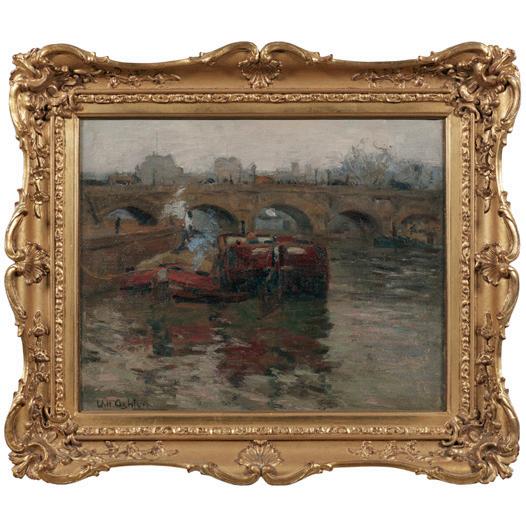
5 WILL ASHTON (1881-1963)
(The Pont Neuf, Paris) oil on canvas signed lower left: Will. Ashton. 43 x 54cm
provenance
(possibly) The South Australian Society of Arts, Adelaide Lawsons, Sydney, 23 April 2001, lot 32 Private collection, Western Australia
exhibitions (possibly) Exhibition of Paintings and Drawings by Mr Will Ashton, The South Australian Society of Arts, Adelaide, October 1915, cat. no. 81 $5,000-7,000
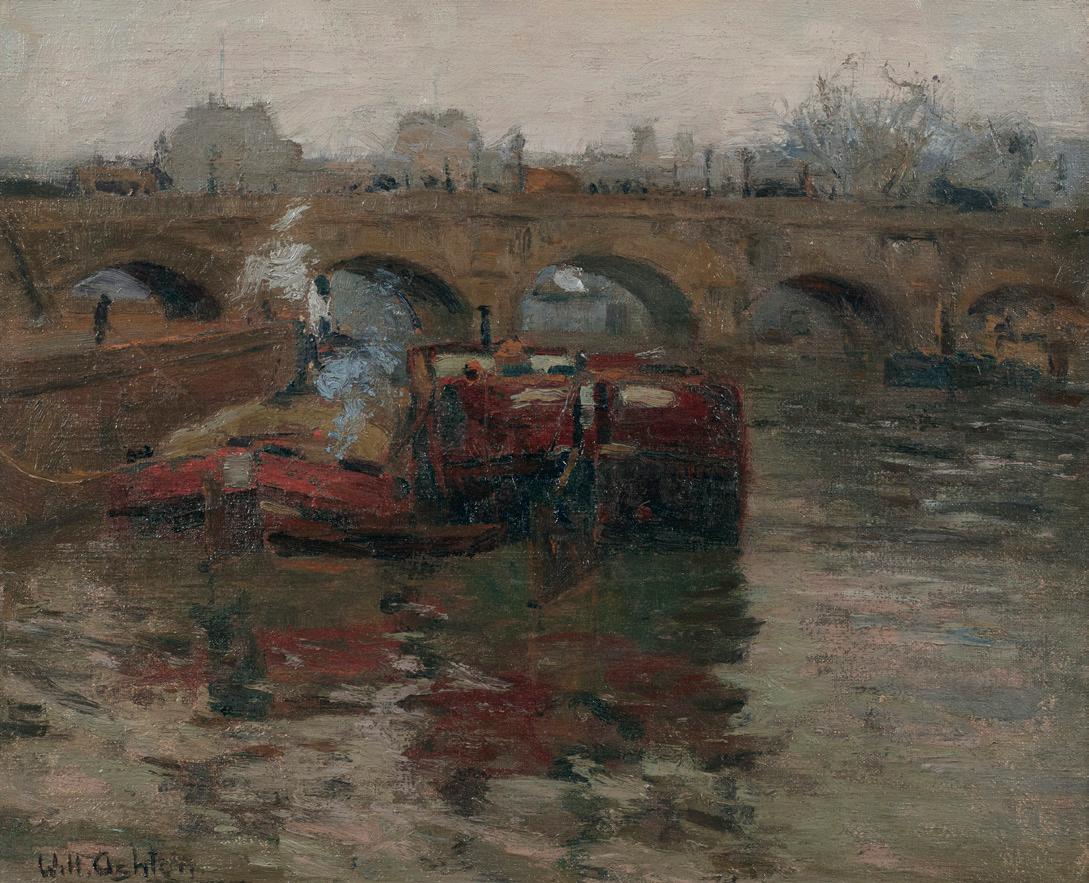
Will Ashton
Throughout his distinguished career, Sir John William Ashton (1881–1963), better known as Will Ashton, captured the world in transition; scenes such as bridges and boats, boulevards and harbours are rendered with an immediacy and vibrancy that aligned him with the broader Impressionist movement. Though often considered through the lens of Australian art history, Ashton’s artistic identity was deeply international, shaped by years abroad and an enduring fascination with the atmospheric effects of European light and landscape.
Born in York, England and migrating to Adelaide as a young boy, Ashton studied at the South Australian School of Art before furthering his training in Europe, notably at the Académie Julian in Paris in the winter of 1902-1903 with other artists including Emanuel Phillips Fox and Hans Heysen.1 It was here, amid the inspiring artistic atmosphere of Paris, that Ashton developed a deep affinity with the Impressionist principles that had revolutionised painting only a generation before. Like the Impressionists, Ashton sought to capture fleeting moments of beauty; the transient effects of light on water, the glint of sun on stone, or the subdued haze of a winter afternoon.
Among his most evocative works are his Parisian cityscapes, especially those depicting the historic bridges of the Seine. In paintings of the Pont Neuf, the city’s oldest standing bridge, Ashton revels in the soft tonal shifts of grey skies and dusky riverbanks. His brushwork is characteristically loose and fluid, allowing form to emerge through suggestion rather than precision. The enduring bustle of the city is balanced by a quiet lyricism and his bridges are not just architectural subjects, but liminal spaces where people and place, history and movement, intersect. These works align Ashton with the French Impressionists and also with British contemporaries like Philip Wilson Steer, who shared a fascination with the urban landscape filtered through changing light.
Equally notable are Ashton’s harbour and maritime scenes. The paintings of moored boats, sailing vessels, and busy docks, produced in both European ports and Australian coastal towns, display a deft sensitivity to reflection and rhythm. Ashton had a remarkable eye for the play of light on water, often capturing the ripple of tide or the glow of varnished hulls with sharp, assured brush strokes. These paintings exemplify the artist's command of compositional balance and atmospheric depth. Whether painting the crowded jetties of Sydney or the serene inlets of Brittany, Ashton found in maritime subjects a perfect vehicle for his painterly instincts and his lifelong fascination with movement.
The selection of paintings offered in this auction, highlight the enduring appeal of Ashton’s practice. Each reveals his Impressionist sensibility and his ability to translate immediate experience into a cohesive, luminous scene captured in time. Together, they exemplify an artist who was grounded in traditional draftsmanship, while embracing a modern approach to light, composition, and expression. Ashton’s legacy lies not only in his contributions to Australian art institutions, including his tenure as Director of the Art Gallery of New South Wales from 1937-1943, but also in these enduring artworks, which highlight a world forever in motion.
amanda north senior fine art specialist
1. Harper, K., ‘Ashton, Sir John William (Will) (1881–1963)’, Australian Dictionary of Biography, National Centre of Biography, Australian National University, https://adb.anu.edu.au/biography/ ashton-sir-john-william-will-5071/text8457, published first in hardcopy 1979, accessed online 1 July 2025.
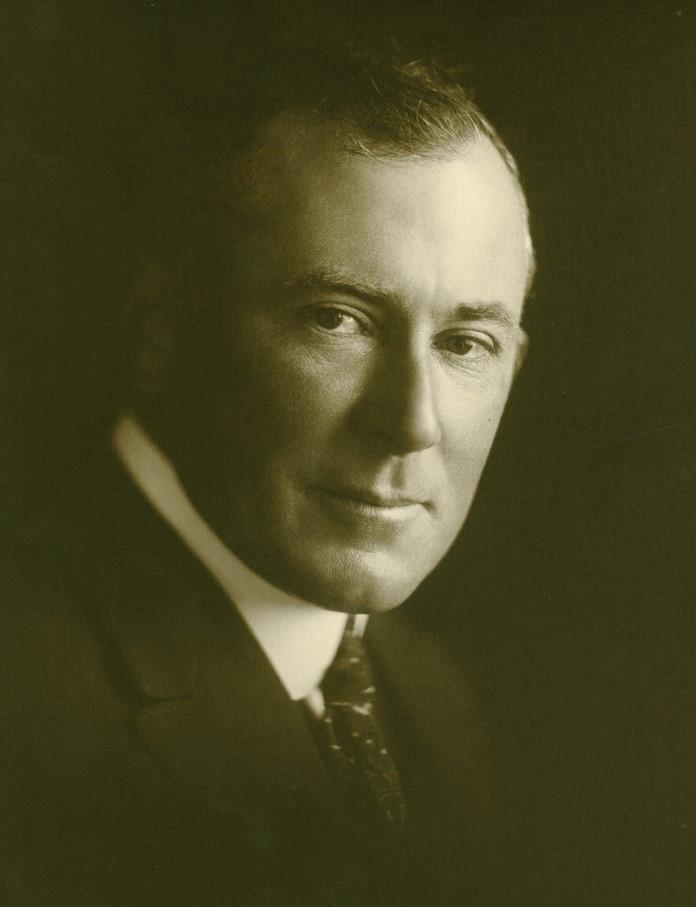


6
TOM ROBERTS (1856-1931)
Dandenongs Landscape c.1924
oil on board
signed lower left: T Roberts. artist’s name, title and date on exhibition label affixed verso
29 x 39.5cm
provenance
The Collection of Dr Joseph Brown, Melbourne Christies, Paintings From The Dr Joseph Brown Collection, Melbourne, 17 May 2005, lot 26 Private collection, Western Australia
exhibitions
The Joseph Brown Collection, National Gallery of Victoria, Melbourne, 31 October - 7 December 1980, cat. no. 39
A Century of Australian Landscape, International Cultural Corporation of Australia, 15 October 1983 - 15 July 1984, cat. no. 45 (as “Australian Landscape”) (label verso)
Australian Paintings from The Joseph Brown Collection, Art Gallery of New South Wales, Sydney, 4 May - 18 June 1989, cat. no. 14
literature
Topliss, H., Tom Roberts 1856-1931: A Catalogue Raisonné, Oxford University Press, Melbourne, 1985, vol. I, pp. 221, 231; vol. II, cat. no. 608, pl. 230 (illus.) (as “Untitled, Dandenongs Landscape”)
Thomas, D., Outlines of Australian Art: The Joseph Brown Collection, Melbourne, 3rd edition, 1989, p. 61, pl. 77 (illus.) (as “Australian Landscape”) (unpaginated)
Pearce, B., Australian Paintings from The Joseph Brown Collection, Sydney, 1989, cat. no. 14 (illus., front cover) (as “Australian Landscape”) (unpaginated)
$80,000-120,000
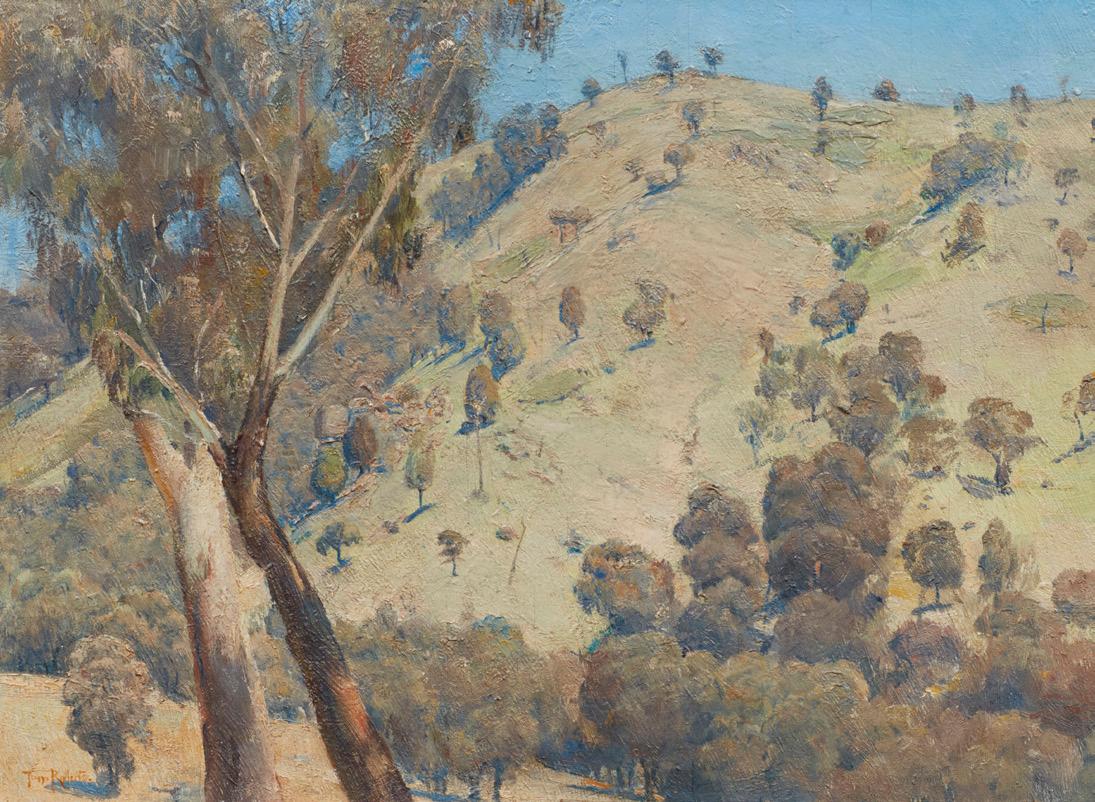

7
ARTHUR STREETON (1867-1943)
(Bamburgh Castle) c.1908
oil on canvas
signed lower left: A.STREETON 50 x 65cm
provenance
Leonard Joel, Melbourne, 5 November 1986, lot 50 (as “Bamborough Castle”)
Private collection, Western Australia
Leonard Joel, Melbourne, 28 November 2017, lot 48 (as “Bamborough Castle”)
Private collection, Western Australia
related work
Arthur Streeton, Bamboro Castle, Northumberland 1908, watercolour on paper, 23 x 31cm, Mossgreen Auctions, Melbourne, 29 August 2016, lot 35; Galbally, A., Arthur Streeton, Lansdowne Press, Melbourne, 1979, p. 77, cat. no. 24 (illus.)
other notes
Arthur Streeton’s depictions of Bamburgh Castle followed his travels and stay in England. Towering above the Northumberland coastline, Bamburgh Castle which is steeped in centuries of history, offered Streeton a dramatic subject; a castle balanced between vast skies and choppy seas. The artworks of this castle reveal Streeton’s enduring fascination with light and atmosphere, applied now to the English landscape rather than his native Australia.
Streeton’s treatment of Bamburgh Castle, captures both the monumentality of the medieval fortress and the subtle tonal shifts of its environment. His brushwork remains loose yet purposeful, the castle rendered with a luminous solidity that contrasts with the softness of the sand dunes and sea. While the subject was new, the approach of capturing grandeur through light, remained distinctively Streeton.
Streeton’s small series of artworks depicting this castle, were painted during trips to the English countryside, often for commissions or personal interest. They reflect his assimilation of British romantic landscape traditions, while maintaining his own plein-air sensibility. Streeton’s Bamburgh Castle paintings are not just topographical records but atmospheric meditations on place, time, and mood of this rugged landscape.
$50,000-60,000

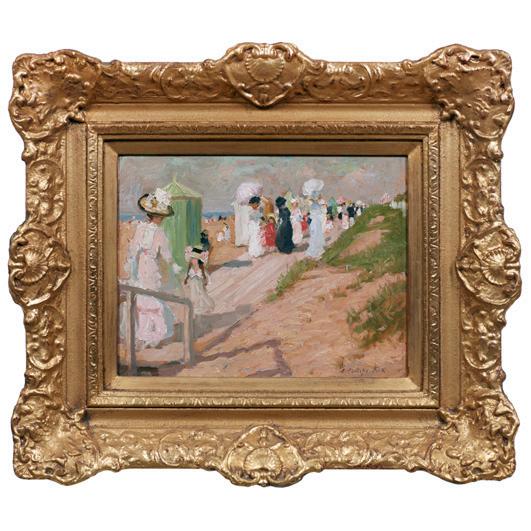
8
EMANUEL PHILLIPS FOX (1865-1915) (Promenade on the Beach) c.1909 oil on panel signed lower right: E. Phillips Fox 26 x 34cm
provenance
GFL Fine Art, Perth, 27 July 1999, lot 16 Private collection
GFL Fine Art, Perth, 26 June 2001, lot 37 Private collection, Western Australia
exhibitions
Painted Women: Australian Artists in Europe at the Turn of the Century, Lawrence Wilson Art Gallery, The University of Western Australia, Perth, 24 July -13 September 1998, cat. no. 30
literature
Grey, A. (ed.), Zubans, R., Images of Women in the Work of Emanuel Phillips Fox and Ethel Carrick Fox, Painted Women: Australian Artists in Europe at the Turn of the Century, The University of Western Australia, Perth, 1998, pp. 14 (illus.), 16, 40, cat. no. 30
related work
Emanuel Phillips Fox, Promenade c.1909, oil on wood panel, 26.6 x 35cm, The Collection of the National Gallery of Australia, Canberra
$80,000-120,000

Emanuel Phillips Fox
After their marriage in London in 1905, Ethel Carrick Fox (1872–1952) and Emanuel Phillips Fox (1865–1915) settled into a routine of summers spent following the sunlight to crowded French sea resorts, painting and sketching the leisurely crowds on small boards or canvases, then returning to their studio apartment in Paris to paint larger works.
Their influence on each other was apparent from their honeymoon. Fox’s style loosened when working on smaller boards, and his great facility with oil paint, honed by years of academic training and teaching, became truly virtuosic in capturing light effects on dresses, sands and figures. His studio practice remained quite focused on a variation of the French intimiste painters, Pierre Bonnard and Édouard Vuillard, with large-scale studies of languorous women in gardens or private interior spaces, as well as commissioned portraits for necessary income. Fox’s academic training led him to separate these two modes of working; his oil sketches were not generally exhibited in Paris, whilst Carrick, less attentive to highly finished studio production, regularly exhibited her rapidly executed sketches in major exhibitions such as the annual Salon d’Automne.
In 1908, Fox visited Australia to see his family and introduce them to his new wife. The couple kept working during the trip, seeking out the leisure pursuits of family picnics and days at the beach as subjects.1 Whilst sea bathing had been popular since the 1840s around Melbourne, in 1908, mixed ocean bathing in daylight hours was still a very new phenomenon. In (Port Phillip, Melbourne) c.1908 (Lot 2), we see the elegant Edwardian silhouette of a woman in a long voluminous skirt, white shirt and pink picture hat observing two swimmers in the shallows, their clothing casually piled next to her on the sand. Underneath a wide, pink-tinged cloud-scumbled sky, a small sailboat bobs further out at a distance, close to the other side of the bay. This work demonstrates Fox’s ability to adapt his plein air technique to the more relaxed social conventions of Australian beach culture, where the emphasis was on leisure rather than formal promenading.
In contrast to the casualness of beach crowds in Australia, (Promenade on the Beach) c.1909 (Lot 8) depicts a crowded afternoon by the beach at a fashionable French sea resort. We see bathing boxes, but our focus is not on swimmers or those lounging on the sands. Instead, we observe the stylish upper bourgeoisie classes en promenade along the planches or timber boardwalk, suggesting they are probably at Trouville or Deauville. Dressed in long flowing dresses replete with ribbons, ruffles, picture hats and parasols, these figures are captured in lusciously applied thick, sweeping strokes of paint, the impasto itself reflecting light and creating movement. Juliette Peers has pointed out that Fox was an accurate recorder of fashion, and the Foxes kept a shared garment collection that appears in many of the couple’s paintings.2 Peers notes that the selection and observation of dress and styling were intrinsic to making Fox’s ideal women and imagined muses tangible.3 As Ruth Zubans has noted, ‘one of Fox’s favourite themes was women in the familial role of mother’,4 and the mother in a pink ruffled gown elegantly reaching for her pigtailed daughter’s hand in the foreground suggest a graceful ease and tender refinement. Indeed, in (Promenade on the Beach) c.1909, the subjects are observably all women - mothers and children, as well as the nannies tending to them.
In contrast to the public, clothed figures of these beach scenes, Fox’s more intimate, private world is depicted in Nu En Plein Air c.1911 (Lot 11). Whilst initially seeming to be a very simple subject, Fox has set himself considerable challenges in the work’s composition and the application of paint. In the privacy of the garden of the Foxes’ Boulevard Arago apartment in Paris, this flame-haired sensuous nude (one of many red-haired models preferred by Fox, which included the Australian artist Edith Susan Gerard Anderson) lounges diagonally across a bed of bright green, light-flecked grass, with Fox leaving areas of the light brown bare canvas to aid the delicate effect. As Fox described in a letter to his friend Hans Heysen: ‘Since we have been in Paris, painting nudes out of doors, in our garden—we have fixed things up so that no one can see, & we are not disturbed—very interesting work, but mighty difficult’.5 The foreshortened model’s pose is contemplative, deep in thought and less aware of the viewer than many of the other nudes in this series. Her translucent skin is highlighted by dappling flecks of lighter paint suggestive of flickering sunlight through a tree canopy, conveying something of the swiftness and dexterity that Fox had to employ to capture the scene.
The atmosphere of ease and wellbeing radiating from many of Fox’s paintings of the Edwardian period recalls a way of life that would disappear forever upon the onset of the First World War. During this period, the French resort towns including Trouville and Deauville were transformed into military hospitals and convalescent homes for wounded soldiers. After losing E. Phillips Fox to cancer in 1915, Carrick would return to these resorts and document new fashions and social mores as the crowds returned in the interwar years.
angela goddard
Angela Goddard is former curator of Australian Art at Queensland Art Gallery | Gallery of Modern Art, Brisbane where she curated 'Art, Love and Life: Ethel Carrick and E. Phillips Fox' in 2011.

References:
1. See the photograph by David Fox on p.148 of Art, Love & Life catalogue for Fox and Carrick at a family picnic on Chelsea Beach, Port Phillip Bay.
2. Peers, J., ‘Tall, graceful women sweep by’: Fashion and dress in the work of the Foxes’, in Art, Love & Life: Ethel Carrick and E. Phillips Fox, Queensland Art Gallery | Gallery of Modern Art, Brisbane, 2011, p.96.
3. Ibid, p.100.
4. Zubans, R., ‘Images of Women in the Work of Emanuel Phillips Fox and Ethel Carrick Fox’, Painted Women: Australian Artists in Europe at the Turn of the Century, The University of Western Australia, Perth, 1998, p.16.
5. Fox to Heysen, September 1911, quoted in Zubans, R., E. Phillips Fox, His Life and Art, Melbourne University Press, Melbourne, 1995, pp.155-56.
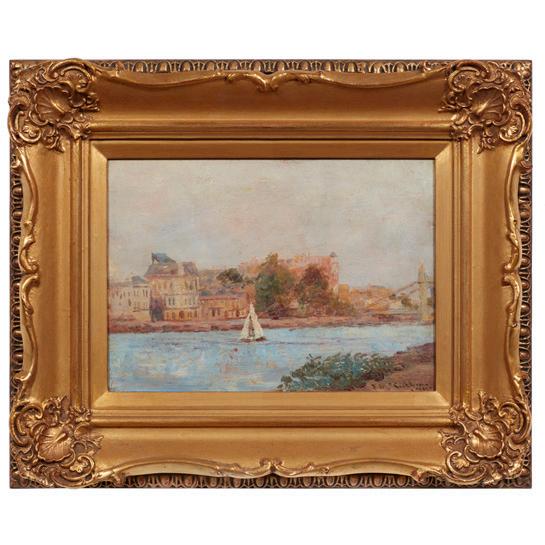
9
FREDERICK MCCUBBIN (1855-1917)
Hammersmith Bridge c.1907
oil on board
signed and dated lower right: F. McCubbin/ 1907 inscribed verso: Hammersmith Bridge, London/ by Frederick McCubbin/ [sic] to England 1907
artist’s name and title on gallery label verso
24 x 33.5cm
provenance
Sedon Galleries, Melbourne (label verso)
Leonard Joel, Melbourne, 22 November 1995, lot 102
Private collection, Melbourne
Christie’s, Melbourne, 27 August 2002, lot 80
Private collection, Western Australia
literature
MacDonald, J. S. et al., The Art of Frederick McCubbin, Lothian Publishing Company, Melbourne, 1916, p. 97
MacDonald, J. S. et al., The Art of Frederick McCubbin, Boolarong Publications, Brisbane, 1986, p. 97
Mackenzie, A., Frederick McCubbin 1855-1917, ‘The Proff’ and his Art, Mannagum Press, Victoria, 1990, p. 136
$25,000-35,000

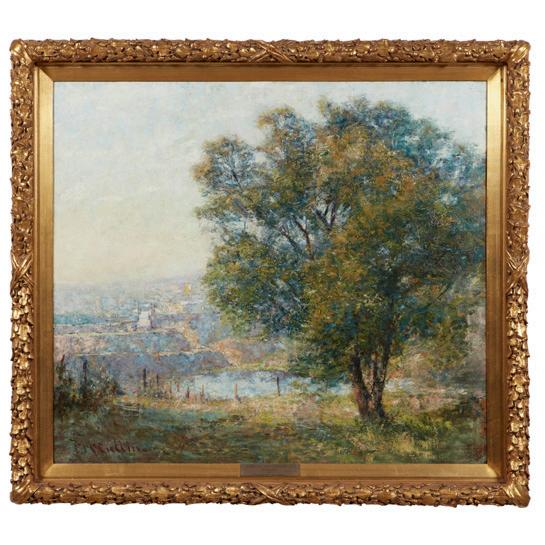
FREDERICK MCCUBBIN (1855-1917)
The Lime Tree (Yarra River from Kensington Road, South Yarra) 1917 oil on canvas mounted on panel signed lower left: F.McCubbin artist’s name and title of frame plaque artist’s name, title and date on gallery labels verso 97 x 110cm
provenance
Mrs McCubbin, Melbourne
The Collection of Thomas C. Lothian, Melbourne Artlovers Gallery, Sydney (as “Yarra River from Top of Kensington Road”) (label verso) Elder Smith Goldsbrough Mort, Adelaide 1971 Elders IXL, Adelaide 1985
Foster’s Brewing, Melbourne (as “Yarra River Top of Kensington Road, South Yarra”) (label verso)
Sotheby’s, The Foster’s Collection of Australian Art, Melbourne, 23 May 2005, lot 24 (as “Yarra River from Kensington Road, South Yarra”)
Private collection, Western Australia
exhibitions
Elders IXL Collection: Masterworks of Australian Painting and French Barbizon School, Colonial, Contemporary, Continental, Art Gallery of South Australia, Adelaide, 2 March - 1 April 1984, cat. no. 47
Portrait of Australia 1830-1930: The Elders IXL Collection, Riddoch Art Gallery, South Australia, 25 April1 June 1986
The Art of Frederick McCubbin 1855-1917, National Gallery of Victoria, Melbourne, 18 December 1991 -
25 February 1992; touring to Art Gallery of Western Australia, Perth, 16 April - 1 June; Art Gallery of South Australia, Adelaide, 26 June - 9 August; Art Gallery of New South Wales, Sydney, 31 August11 October; Queensland Art Gallery, Brisbane, 28 October - 6 December 1992, cat. no. 54 (as “Yarra River from Kensington Road South Yarra”) (label verso) McCubbin: Last Impressions, National Gallery of Australia, Canberra,14 August - 1 November 2009; Art Gallery of Western Australia, Perth, 12 December 2009 - 28 March 2010; Bendigo Art Gallery, Victoria, 24 April - 25 July 2010, cat. no. 73 (label verso)
literature
Radford, R., Elders IXL Collection: Masterworks of Australian Painting and French Barbizon School, Colonial, Contemporary, Continental, Art Gallery of South Australia, Adelaide, 1984, p. 36, cat. no. 18 (illus.)
Radford, R., Luhrs, P. et al., Portrait of Australia: Elders IXL Collection, Elders IXL Limited, Melbourne, 1986, pp. 40-41, cat. no. 27 (illus.)
Mackenzie, A., Frederick McCubbin 1855-1917, ‘The Proff’ and his Art, Mannagum Press, Victoria, 1990, pp. 208-09, cat. no. 67 (illus.) (as “Yarra River from Kensington Road”)
Whitelaw, B., The Art of Frederick McCubbin, National Gallery of Victoria, Melbourne, 1991, pp. 128-29 (illus.), 135, cat. no. 54 (as “Yarra River from Kensington Road South Yarra”)
Gray, A., McCubbin Last Impressions 1907-17, National Gallery of Australia, Canberra, 2009, pp. 153 (illus.), 161, cat. no. 73
$600,000-800,000

Frederick McCubbin
The Lime Tree
The Lime Tree (1917) (Lot 10) by Frederick McCubbin (1855–1917), also known as Yarra River from Kensington Road, South Yarra, is a moving work that marks the end of an extraordinary career. Painted from the side veranda of McCubbin’s home in South Yarra, it captures not only a view of his own backyard but also the serenity and beauty of a place that was very important to him in his final years. It stands as both an artistic and deeply personal homage to the property and its surroundings, rendered with the sensitivity and maturity that characterised his late style. Its importance is recognised by its inclusion in the significant travelling exhibition McCubbin: Last Impressions, which was represented at the National Gallery of Australia, Canberra Art Gallery of Western Australia and Victoria Bendigo Art Gallery between 2009 and 2010.
McCubbin moved to South Yarra in 1907, shortly after returning from a brief trip to Europe. One can imagine the tranquillity the property offered, a striking contrast to the noise and chaos of European cities. The relocation marked the beginning of his final chapter.
“The McCubbin family moved to ‘Carlesberg’ at 42 Kensington Road, South Yarra in 1907, shortly after McCubbin’s return from overseas. It was one of the earliest houses in Melbourne, and consisted of approximately 10 rooms and a verandah. By the time the McCubbins lived there, the property had been reduced to approximately three acres and ran from Kensington Road down to the Yarra.”1
Immediately McCubbin felt a deep affinity to the place and the garden became an important subject for his paintings. As McCubbin wrote to his close friend Tom Roberts in 1907:
“This is the loveliest place I have ever lived in. A charming old colonial house perched right over the Yarra with three acres of garden and trees... The winding stream, gums, osiers and wattle; interspersed. The night effects; sunrise, moonrise, we can see every way.”2
Part of these surroundings is the majestic The Lime Tree McCubbin painted and this work is widely considered to be the last work by the artist to be completed. The work depicts the very view he cherished in life. His daughter Kathleen recalls her memories surrounding its creation:
“I always remember the name of this work as The Lime Tree and it really has a lot of sentimental value for me because it was painted from the side verandah of our house in South Yarra, overlooking the quarry...This particular painting is also of very great sentimental value for me because it was the last painting my father ever painted and it was not long after its completion that he died.
I remember coming home from school... I would see my father sitting on the verandah in his dressing-gown and black velvet beret... and he would be painting this picture of The Lime Tree. He was in really poor health at the time, but he persisted, and he kept on painting until it was finished.”3
The painting is not only deeply sentimental, but it also reveals the maturity of McCubbin’s technique. By this stage, his style had become increasingly loose, expressive, and rich in atmosphere. It is a canvas that captures the spirit of nature as much as the artist’s love for the garden’s beauty.
The Lime Tree is not just a final painting; it is a final vision. It stands for the poetic sensibility that defined McCubbin’s approach to the Australian landscape a painter at peace with his environment. Expressing in luminous colour and form the deep contentment he had found in his house above the Yarra.
“McCubbin’s art was most remarkable during his final years…His daring, his experimental painterliness, and his ability to capture the Australian landscape produced some incredible work.”4
wiebke brix head of art
1. Elena Taylor, https://digital.nga.gov.au/archive/exhibition/mccubbin
2. McCubbin to Roberts, December 1907, Letters to Tom Roberts, vol. II, Mitchell Library, State Library of New South Wales, Sydney
3. Gray, A., McCubbin Last Impressions 1907-17, National Gallery of Australia, Canberra, 2009, p. 153
4. Gray A. cited in Perkin C., ‘Such Dreams of Colour’, Weekend Australian, 8 – 9 August 2009, p.4
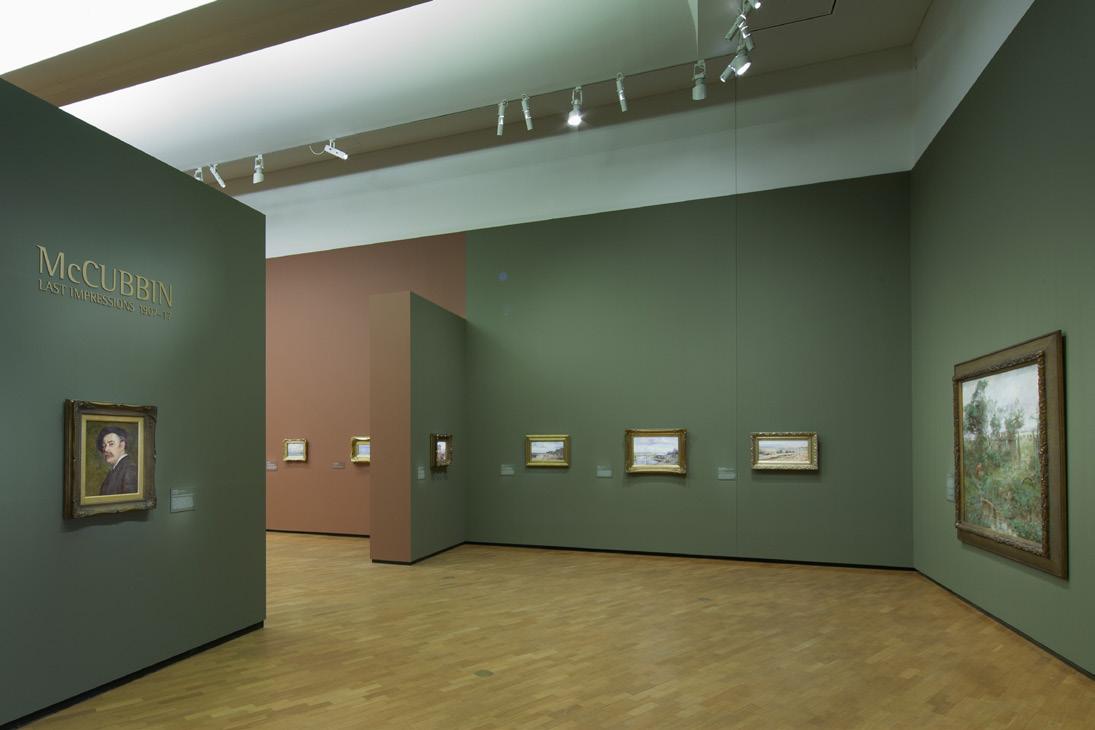


11
EMANUEL PHILLIPS FOX (1865-1915)
Nu En Plein Air c.1911 oil on canvas
signed lower right: E. Phillips Fox artist’s name and title on gallery labels verso 63 x 79cm
provenance
Whiteford and Hughes, London, cat. no. 26 (as “Reverie”) (label verso)
Private collection, Melbourne
Christie’s, Melbourne, 27 April 1998, lot 33
Private collection, Sydney
Christopher Day Gallery, Sydney 2006 (label verso)
Private collection, Western Australia
exhibitions (possibly) Salon d’Automne 1912, cat. no. 589 or (possibly) Societe Internationale de Peinture et de Sculpture, 6 - 31 December 1912, cat. no. 47 (as “Vue en plein air”)
literature
Zubans, R., E. Phillips Fox, His Life and Art, The Miegunyah Press, Melbourne University Press, Melbourne, 1995, pp. 156 (illus.), 227, cat. no. 383
“An important category of work which became part of Fox’s repertoire after his return to Paris was the painting of the nude. The monumentality and unselfconsciousness with which he approached this theme could not have developed outside the French context. These works emerge rather later in Fox’s career and are first mentioned in a letter to Norman Carter in September 1909: ‘I have be doing some small nudes lately...” Writing to Heysen in September 1911, he elaborates:
‘Since we have been in Paris, painting nudes out of doors, in our garden - we have fixed things up so that no one can see, & we are not disturbed - very interesting work, but mighty difficult - I try to complete a 25 canvas at one go - for better or worse - I find I get better results - coming back when one is not in the same attitude generally busts up the show’” (p.155)
related work
Emanuel Phillips Fox, Nude in Sunlight c.1911, oil on canvas on masonite backing, 61 x 74cm, Private collection, Zubans, R., E. Phillips Fox, His Life and Art, The Miegunyah Press, Melbourne University Press, Melbourne, 1995, pp. 156 (illus.), 227, cat. no. 388
Emanuel Phillips Fox, (The Nude, Study) c.1911, oil on canvas, 63.5 x 79.5cm, Private collection, Melbourne, Zubans, R., E. Phillips Fox, His Life and Art, The Miegunyah Press, Melbourne University Press, Melbourne, 1995, pp. 167 (illus.), 227, cat. no. 385
Emanuel Phillips Fox, Nude (also known as “After the Bath”), oil on canvas, 65 x 81.2cm, The Collection of Kerry Stokes, Perth, Goddard, A., Art, Love and Life: Ethel Carrick Fox and E Phillips Fox, Queensland Art Gallery, Brisbane, 2011, pp. 106-7 (illus.), 157 $80,000-120,000

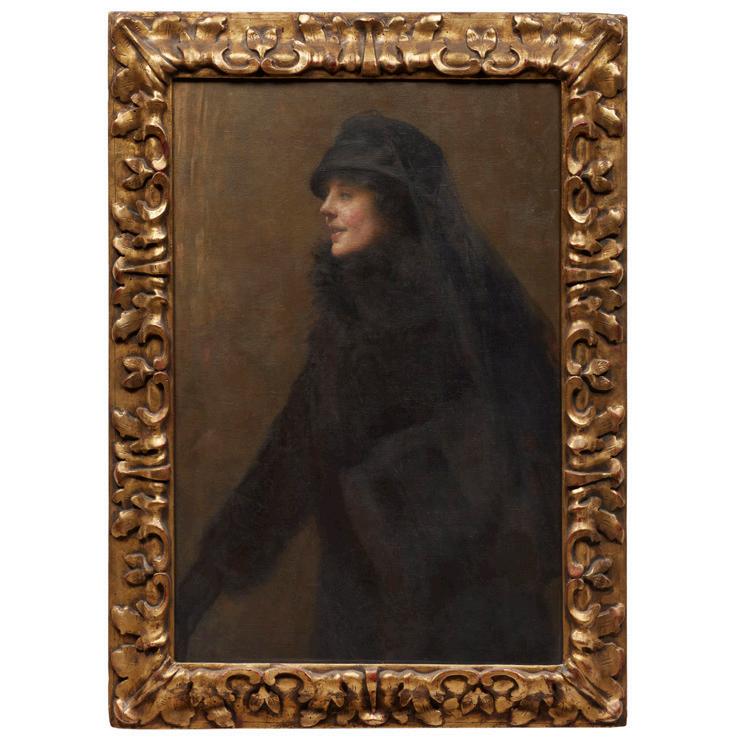
12
TOM ROBERTS (1856-1931)
Portrait of Lady Coghlan 1919
(also known as Untitled, Portrait of a Lady) oil on canvas in the original Lillie Williamson frame signed and dated lower left: Tom Roberts 19. 92.5 x 61cm
provenance
The Collection of Sir Timothy Coghlan, London Thence by descent to his son, Austin Coghlan, London
Christie’s, Melbourne, 6 March 1970, lot 36
Private collection, Melbourne
Private collection, Western Australia
literature
Topliss, H., Tom Roberts 1856–1931: A Catalogue Raisonné, Oxford University Press, Melbourne, 1985, vol. I, p. 190; vol. II, cat. no. 468, pl. 196 (illus.)
(as “Untitled, Portrait of a Lady”)
other notes
The frame surrounding Portrait of Lady Coghlan 1919 is a rare example of early twentieth-century Australian frame-making and one of the few that can be attributed to Elizabeth (‘Lillie’) Williamson, Tom Roberts’s wife.
Williamson, whose contribution to Australian and British frame-making has only recently begun to be acknowledged, was carving frames for Roberts as early as the 1890s. During their years in London, she became a highly respected craftswoman, exhibiting widely.
This carved, richly ornamented frame exemplifies the English Arts and Crafts aesthetic, with organic forms, beautiful ornamentation, and balanced proportions the frame stands out to be made in a very distinctive and unique manner. It not only enhances the visual harmony of the portrait it surrounds but also reflects the collaborative relationship between Roberts and Williamson. It occurs that the portrait and frame are also chosen in gratitude to the sitter Lady Lena and her husband Timothy Coghlan who were great supporters of the arts and Tom Roberts. This beautiful collaboration is as a sign of deep friendship between the philanthropists and artists.
$30,000-50,000
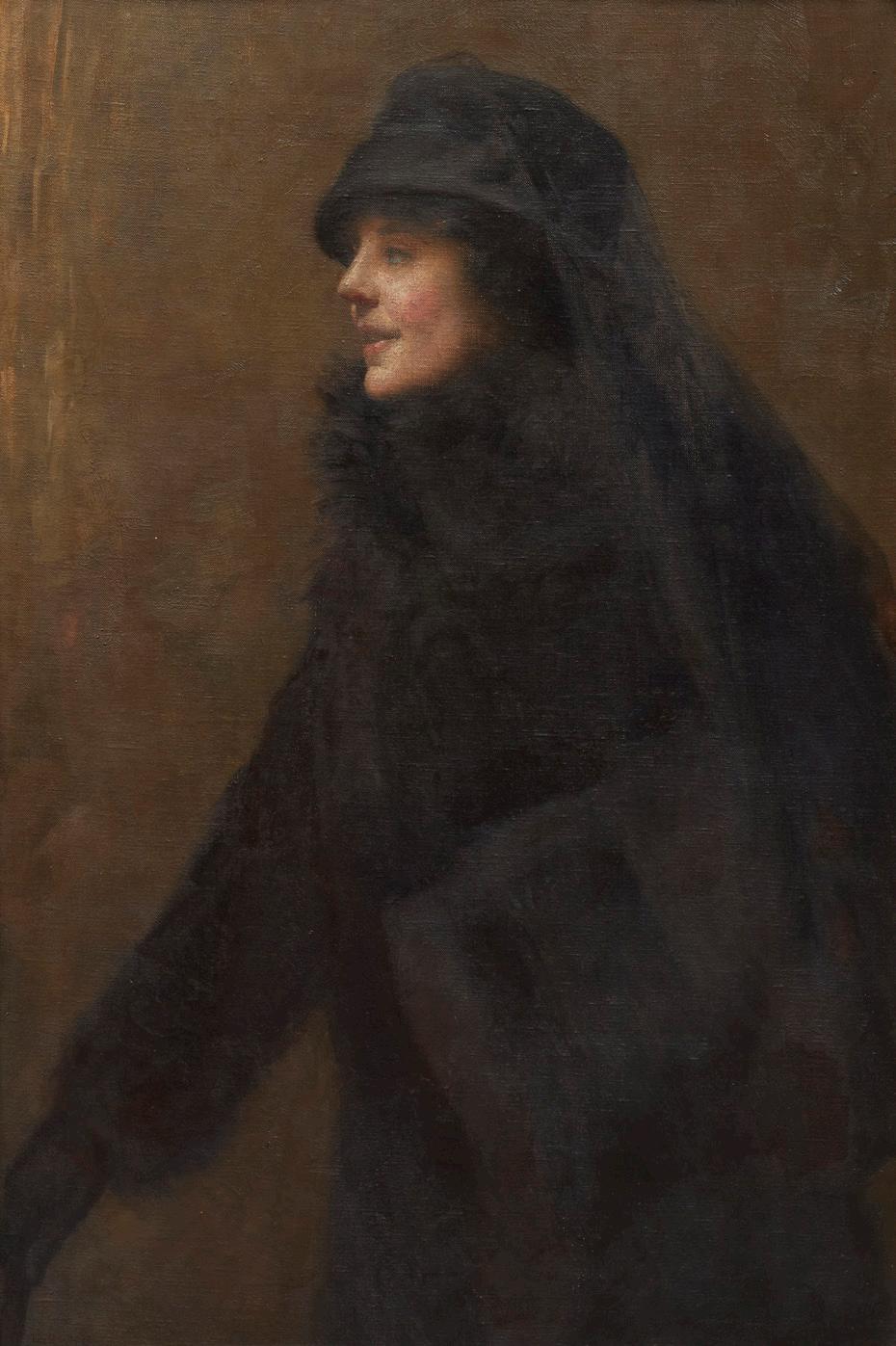
Tom Roberts
Tom Roberts (1856–1931), his wife Lillie and son Caleb journeyed to London in 1903 accompanied by Roberts’s unfinished opus to commemorate the opening of the first federal parliament. Reconnecting with many expat friends, the family remained immersed in the “old country” for many years, Roberts also believing there was greater opportunity for sales of his work. Also present in London were members of his extended family, the demure study of Violet Bancroft (Lot 27) one of a series of portraits of the Bancroft family to whom Roberts was related courtesy of cousin Matilda Iles.
Matilda had married the gregarious Captain Henson Bancroft in 1871 in Melbourne, babies following in quick succession prior to a return to England in 1879 where Violet was born in 1880. Roberts had maintained his association with his cousin’s family during his studies at the Royal Academy in the 1880s and welcomed the renewed friendship when he again arrived in London.
It would not have been an easy and cheerful relationship. In 1908 Captain Bancroft died from poisoning after successive bouts of alcoholism, the ignominy of newspaper articles devouring the sordid details leaving his widow and children mortified. In defiance of such shame and to show the strength of family, in 1914 Roberts embarked upon a series of portraits of Matilda and her four daughters. Trauma is variously inscribed upon the faces of the women, Matilda enclosed in black, appearing encumbered by the life and death of her husband.
For the portrait of Violet, rather than continue the theme of mourning he had employed for her mother, Roberts chooses to present her dressed for a social gathering. A slight tilt forward of the head, gleaming hair clip, delicate string of pearls and white flower pinned upon filmic black chiffon, all enhanced by blushing cheeks, are the accoutrements for a joyous society portrait. But Violet’s eyes cannot escape Roberts’s probing brush, sadness beset within the distant gaze, the daughter reflecting the mother’s trauma. It is an intriguing portrait.
The mood shifts dramatically with the Portrait of Lady Coghlan 1919 (Lot 12) (née Helena (Lena) Donnelly) whereby Roberts returns to one of his favourite motifs of situating women in urban spaces as a sign of modernity. Lady Coghlan wears a most fashionable black walking costume defined by a luxurious high-collared fur coat, black, according to Robert Leong, ‘a sartorial talisman for negotiating the shifting labyrinths of the city.’1 Her costume is complete with a stylish winter hat and veil, a sign of her standing within London society, while her luminous skin glistens in the cold London air against Roberts’s taupe shaded background.
Lady Coghlan was one of 13 children born into a long-serving Australian political family. She was the daughter of Cowra MLA Denis Donnelly and his wife Ellen, while Ellen’s father, William Cummings, was a member of the NSW parliament. The Irish Denis arrived in Australia to seek his fortune during the goldrush, spending time in Ballarat, that association influencing the later choice of Loreto’s Mary Mount for his daughters’ schooling. Established to provide a rounded education for girls, it was a perfect start for Lena Donnelly. While two of her sisters joined the Loreto order, she returned to the Cowra district and entered society.

Lena Donnelly’s marriage to the government statistician, Timothy Coghlan, a principled and forthright public servant, was recorded in the local society pages, but with his appointment as Australia’s agent general in 1905, she was projected into the bustle of twentieth century London. Roberts and Lillie became part of the Coghlan’s social circle, were regularly documented as attending their soirees and luncheon parties, and Timothy provided space for Roberts’s Sloane Street studio.
Lady Coghlan’s support for the broader acknowledgement of Australian artists was boundless and she used every opportunity to promote and showcase their work. She presided over the committee to organise the London version of the 1907 Australian Women’s Work Exhibition, Lillie exhibiting her gilded frames with one fortuitously purchased by Princess Louise (daughter of Queen Victoria). The purchase was widely discussed and initiated a period of increased patronage of her work.
As a thank you to their friendship during the war years, Roberts painted portraits of Sir Timothy and Lady Coghlan in 1919, the portrait of Timothy a conservative though relaxed portrait of a treasured friend. For his portrait of Lady Coghlan, Roberts embraces his love of costume and employs it to convey context and movement, her autonomy suggesting she has no time for a studio sitting. Indeed, in later years Lady Coghlan promoted a sense of freedom, the aeroplane as a means of transport her favourite, and she encouraged women to see the world. Roberts makes clear that her engagement with the external world equates to a masculine-styled flâneur, harking back to his pastel portraits of walking women from the late nineteenth century. He also draws upon his love of the profile portrait, The Paris Hat (New England Regional Art Museum, 1892) and Eileen (Art Gallery of NSW, 1892) typical of his use of the device to convey friendship and the interior reflection of a woman.
The Portrait of Lady Coghlan 1919 (Lot 12) is bordered by an extraordinary gilded and hand carved frame by Lillie. The spectacular art nouveau frame creates a truly alluring picture, the tenderness of the portrait and richly decorated frame an incomparable present for a treasured friend. Although smaller in size, the frame is not dissimilar to the one carved for Roberts’s Penelope (1919) held in the National Gallery of Victoria, the only frame by Lillie held in the collection.
With the end of the war, Roberts journeyed back to Australia for a year in 1919 and was again drawn to the countryside, beginning a body of work brought to fruition when he and Lillie returned permanently in 1923. They bought a house in the Dandenong Ranges, and Roberts commenced studies of his surrounds, gradually bringing to light the drama of sparsely vegetated majestic hills and lush gorges. They are quiet reflective pictures, Dandenongs Landscape (Lot 6) typical of Roberts’s ability to convey his deep respect for the defining motifs of the Australian bush. Two lurching gum trees dominate the composition while the remainder of the canvas is governed by his favoured palette of muted tones. Dotted with the occasional tree, bleached hills stream towards the sky, his work at the time described by Jessie Traill as “thought-out gentle landscapes – they seemed removed from hurry; they had a joy and love in them.”2 Indeed, it could be considered that love, respect and commitment are the abiding themes of all three of the works by Roberts.
dr Julie cotter
Dr Julie Cotter is the author of three books, has worked as a lecturer and in public policy roles, written and presented documentaries, is widely published in a range of journals, magazines and catalogues and has been a member of many public art and grant committees. Her book, Tom Roberts and the Art of Portraiture (Thames & Hudson 2015), was shortlisted for the 2016 Prime Minister’s Literary Award for nonfiction. Her most recent book is Portia Geach: Portrait of an Activist (Joyce Press 2024). It tells the story of the first Australian woman to be admitted to the Royal Academy of the Arts.
1.
2.
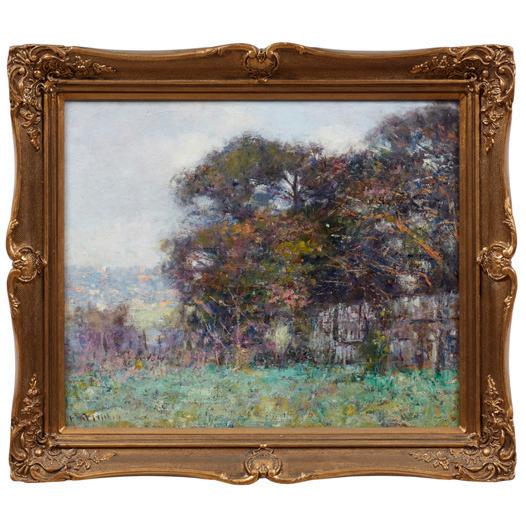
13
The Artist’s Garden, South Yarra oil on canvas signed lower left: F. McCubbin
49.5 x 59.5cm
provenance
The Collection of Mr and Mrs Maurice G. Sloman, Melbourne Estate of the above
Sotheby’s, Melbourne, 2 May 2000, lot 87
The Collection of James and Margaret Bleasel, Melbourne
Christies, The Bleasel Collection of Australian Paintings, Melbourne, 22 March 2005, lot 17
Private collection, Western Australia
$80,000-120,000

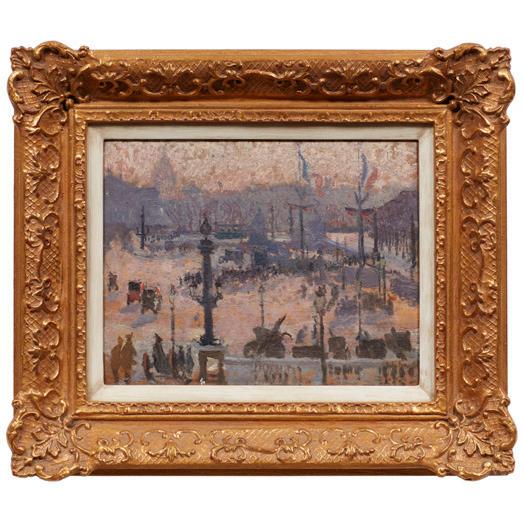
14
EMANUEL PHILLIPS FOX (1865-1915)
(Place de la Concorde, Paris) c.1890
oil on panel signed twice lower right: E. P. Fox inscribed verso: Artist/ E. Phillips Fox. 26 x 33.5cm
provenance
The Collection of John A. Hogan, Melbourne (label verso)
Christie’s, Melbourne, 22 August 2000, lot 94
Private collection, Western Australia
exhibitions
Spring Exhibition, Kozminsky Galleries, Melbourne, 2000, cat. no. 12 (label verso)
$30,000-40,000


15
WALTER WITHERS (1854-1914)
Morning Mist, Eltham oil on canvas signed lower left: Walter Withers artist’s name, title and inscriptions on plaque verso: “MORNING MIST”/ ELTHAM/ BY WALTER WITHERS/ PRESENTED TO/ SEYMOUR DAVIES ESQ./ BY A FEW OF HIS FRIENDS IN RECOLLECTION OF MAY PLEASANT YEARS OF BUSINESS RELATIONSHIP./ MELBOURNE. MARCH 1914
62 x 73.5cm
provenance
The Collection of Seymour Davies Esquire., Melbourne 1914 (plaque verso)
Estate of the above
Sotheby’s, Melbourne, 26 July 1987, lot 486
The Collection of Mr and Mrs Rene Rivkin, Sydney Sotheby’s, The Collection of Mr & Mrs Rene Rivkin, Sydney, 3 June 2001, lot 64
Private collection, Western Australia
$80,000-120,000

Walter Withers
Walter Withers (1854–1914) occupies an important place within the development of Australian impressionism. A key figure of the Heidelberg School, Withers brought to the movement a quieter, more atmospheric sensibility. Where some of his contemporaries pursued dramatic vistas or expansive sun-lit plains, Withers was drawn to the subtleties of tone, shifting weather, and the soft radiance of morning and evening light. In paintings such as Morning Mist, Eltham (Lot 15), his mature style is imbued with delicacy and a deeply personal connection to place.
Born in Warwickshire, England, Withers trained in London and Paris before emigrating to Melbourne in 1888. Finding work as a farm hand on his arrival in Australia, Withers developed a deep connection to rural life, and the slow, contemplative work conducted in natural surrounds. By the early 1890s, he had become closely associated with the artists painting en plein air in the rural outskirts of Melbourne. This circle which included Arthur Streeton, Frederick McCubbin, Charles Condor and Tom Roberts would become to be known as the Heidelberg School. Together, they sought to develop a distinctly Australian vision of the landscape, one grounded in natural light, colour, and direct observation.
During this period Withers lived and worked at Chartersville, a rambling stone homestead in East Ivanhoe that served as a base for several artists from the Heidelberg School. Though often overshadowed by the more extroverted compositions of his peers, Withers’ paintings from this period were praised for their tonal harmony and subtle emotion. As the Age reported in 1894, ‘His work is characterised by its great charm of colour and by an increased suppleness of execution. He brings before us the evanescent charm of a passing hour and makes us feel the “spirit of the season” in the colour and lighting of his landscapes’1
This deep connection to place continued when Withers and his wife Fanny moved to Eltham in 1903. The small rural township north-east of Melbourne offered a rich source of subject matter for an artist attuned to the quieter rhythms of life. Every form of subject was there before him, with the added charm of rural figures at work in the paddocks, tending animals near the homesteads, following cows towards the milking sheds, or riding horses to the creek for water.2 Fanny Withers wrote with fondness of the family’s life in Eltham, ‘purchasing a cottage there, with an orchard attached, he built for himself a charming studio, with windows of which open on to a bit of virgin bush, where stand stately white gums of great beauty.’3
It was here that he painted Morning Mist, Eltham (Lot 15), a quiet contemplative view looking down Brougham Street toward the township, veiled in early morning fog. A lone rider, thought to be mounted on Dolly, the old grey mare owned by the Withers family, makes their way along the road. Cottages emerge faintly through the haze, and the palette is gentle and restrained, with soft mauves, greys, and ochres dissolving into one another.
Withers was known for travelling widely in search of subjects, often by pony and jinker or train, yet many of his finest paintings depict the familiar scenes around his home. He frequently walked or cycled through the countryside with an easel and a prepared canvas over his shoulder, ready to capture fleeting conditions of light and season. His palette was attuned to the subtleties of morning mist, golden afternoons, and the soft silver of winter skies.
Today, Walter Withers is recognised as one of the most accomplished landscape painters of his generation. His works are held in every major Australian public collection, yet it is paintings such as Morning Mist, Eltham (Lot 15) that his legacy is most felt. Modest in subject and unassuming in tone, the painting reflects Withers’ enduring ability to capture the poetry of the everyday to render the ordinary as something quietly profound.
hannah ryan senior art specialist, manager of specialty auctions
1. ‘Exhibition of Pictures. The Victorian Artists’ Society’, Age, Melbourne, 25 October 1894, p. 6
2. Mackenzie, A., Walter Withers: The Forgotten Manuscripts, Mannagum Press, Lilydale, 1987, p. 130
3. Ibid, p. 27


16
FREDERICK MCCUBBIN (1855-1917)
Towards Prahran 1907 oil on canvas
signed and dated lower left: F McCubbin/ 1907 22.5 x 53cm
provenance
The Collection of Mr E. S. Levinson, Adelaide 1962
Private collection, Perth Sotheby’s, Sydney, 7 May 2007, lot 59
Private collection, Western Australia
literature
MacDonald, J. S. et al., The Art of Frederick McCubbin, Lothian Publishing Company, Melbourne, 1916, p. 97 MacDonald, J. S. et al., The Art of Frederick McCubbin, Boolarong Publications, Brisbane, 1986, p. 97
$60,000-80,000

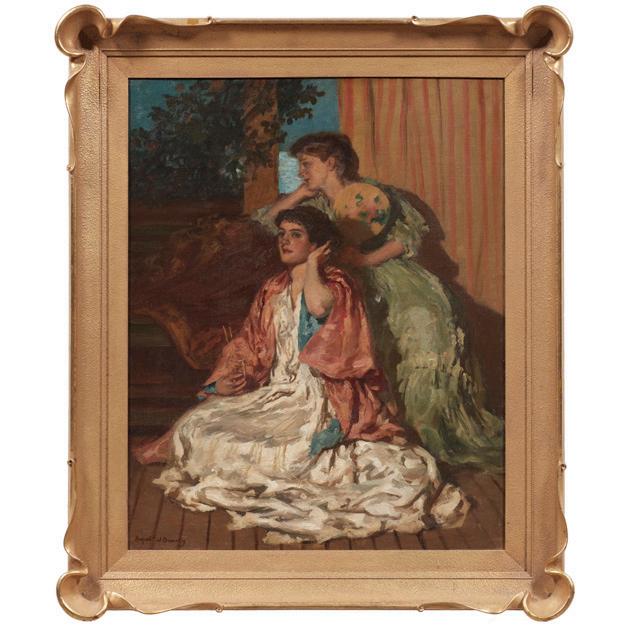
17
RUPERT BUNNY (1864-1947)
The Sonata c.1910
(also known as La Sonate) oil on canvas
signed lower left: Rupert.W Bunny inscribed verso: MRS J FISKEN Yendan/ Rupert Bunny/ £100 inscribed on stretcher bar verso: PROPERTY OF/ Irene L Falkiner/ [sic]/ 1924/ lent to/ father and mother
Stamped ‘95’ on lower stretcher bar verso 80 x 64cm
provenance
The Collection of Mr and Mrs J. F. C. Forsayth, Melbourne
Gifted by the above to their daughter Irene Ida about the time of her marriage to Charles Leslie Falkiner in 1924
Thence by descent to their daughter Patricia (Mrs John Fisken) of Lal Lal Estate, Yendon, Victoria c.1950
Sotheby’s, Sydney, 17 November 1988, lot 233A (as “Moonlight Sonata”)
Private collection, Sydney Christies, Melbourne, 6 May 2003, lot 60 (as “Moonlight Sonata”)
Private collection, Western Australia
exhibitions
Exhibition of Pictures by Rupert Bunny, Athenaeum Gallery, Melbourne, 24 July - 14 August, 1911, cat. no. 9
Société Nationale des Beaux Arts, Lyon, 1912, cat. no. 226 (as “La Sonate”)
Société Nationale des Beaux Arts, Lyon, 1921, cat. no. 212
literature
Gérard-Austin, A., The Greatest Voyage: Australian Painters in the Paris Salons, 1885-1939, doctoral thesis, Universite Paris 1 - Pantheon-Sorbonne, March 2014, vol. 2, pp. 18, 83, 128 (illus.)
Thomas, D., The Life and Art of Rupert Bunny: A Catalogue Raisonné in Two Volumes, Thames & Hudson, Melbourne, 2017, vol. 2, p. 46, cat. no. O320
related work
Rupert Bunny, Une Nuit de Canicule, oil on canvas, 227 x 249cm, Leonard Joel, 2 November 1988, lot 125, since destroyed in a fire, London.
(When this painting was sold at Leonard Joel in 1988, the price of $1,250,000 was a record for an Australian painting).
A painting of the same title is held in The Collection of the Art Gallery of Ballarat, Victoria.
$200,000-300,000

Rupert Bunny
The Sonata
Rupert Bunny’s (1864–1947) The Sonata (c.1910) (Lot 17) is a refined example from his Nights and Days of August series, painted between 1907 and early 1911 during his time in France. This body of work centres on intimate interior and balcony settings featuring women in moments of quiet introspection, draped in embroidered robes, fans and music, set against a backdrop of moonlight and distant sea.
In The Sonata (Lot 17), two women are positioned within a domestic setting. The seated figure, Bunny’s wife Jeanne Morel, wears a white gown with a soft pink robe, gazing introspectively as she adjusts her hair and loosely holds an empty glass. Standing behind her, the women in green gently leans forward, looking outward. Behind them, the curtain is parted to reveal a glimpse of the moonlit sea. The palette is subdued and warm with the striped drapery and timber floor proving compositional structure. The mood is quiet, observational, and reflective, qualities that typify Bunny’s work from this period.
The painting was included in Bunny’s major solo exhibition at the Athenaeum Gallery, Melbourne, in July 1911. Opened by the Governor of Victoria, Sir John Fuller, one hundred and three paintings were listed in the catalogue, selected from the previous ten years of his oeuvre.1 The Sonata appeared as No. 9 in the exhibition catalogue, priced at 50 guineas, and was acquired by J. F. C. Forsayth, a prominent collector and director of the Burns Philp Company. It remained in the Forsayth family for several decades and was gifted by Mr and Mrs Forsayth to their daughter Irene at the time of her marriage to Charles Leslie Falkiner, nephew of Leigh Sadlier Falkiner of Wanganella Station, Deniliquin. Around 1950, Irene Falkiner passed the painting on to her daughter, Patricia Fisken.
The Sonata shares thematic affinities with other works from the same series, including Nocturne (c.1908) and The Distant Song (c.1910) in the collection of the National Gallery of Australia, Canberra, and another painting also titled The Sonata (c.1910) (Lot 17) in the collection of the Art Gallery of Ballarat, Victoria. The Ballarat painting, larger in scale and depicting three figures, shares compositional and thematic similarities, but the present work is more restrained, both in size and atmosphere. A similar example, Une Nuit de Canicule (c.1910) was sold by Leonard Joel in 1988 for $1.25 million and was the first million-dollar painting sold at auction in Australia.
The Sonata (Lot 17) holds lasting cultural and art historical significance as a key work of Rupert Bunny’s mature style, capturing the harmony between European elegance and introspective subject matter that defined his most celebrated period.
hannah ryan
senior art specialist, manager of specialty auctions
1. Thomas, D., The Life and Art of Rupert Bunny: A Catalogue Raisonné in Two Volumes, Thames & Hudson, Melbourne, 2017, p.146

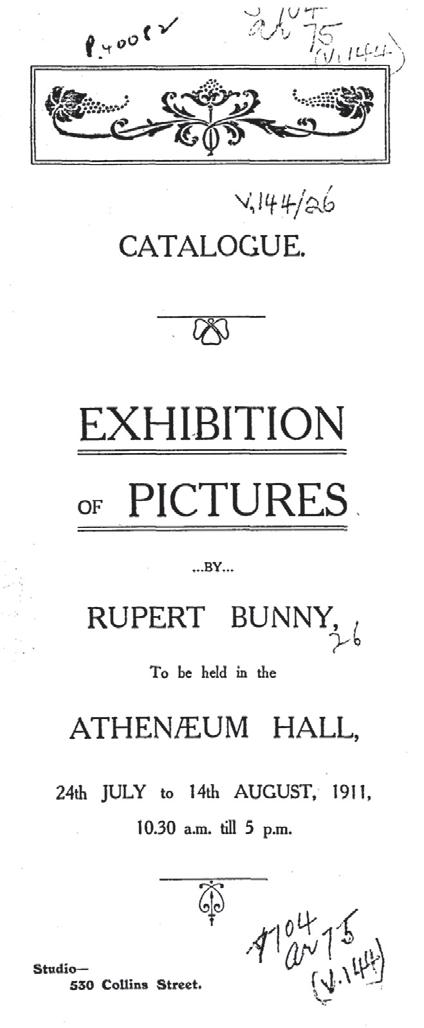

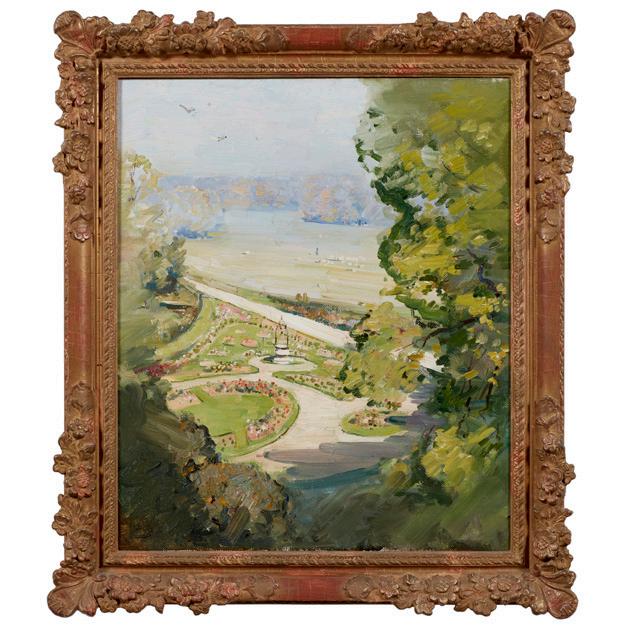
18
ARTHUR STREETON (1867-1943)
The Rose Garden, Coombe Bank c.1913
oil on canvas initialled lower left: A.S.
inscribed verso: THE ROSE GARDEN/ COMMISSIONED BY SIR ROBERT MOND
artist’s name and title on unknown label verso 60.5 x 50cm
provenance
(possibly) Sir Robert Mond, Coombe Bank, United Kingdom
Masterpiece Gallery, Hobart 1985
Private collection, Hobart
Leski Auctions, Melbourne, 15 December 2009, lot 3
Private collection, Western Australia
other notes
In the spring of 1913, Arthur Streeton accepted a commission from Robert Mond to paint a series of landscapes depicting the grounds and surrounds of Coombe Bank, a grand Palladian estate located in Sevenoaks, Kent. The commission marked an important moment in Streeton’s English period and resulted in a series of lyrical works celebrating the cultivated beauty of the English countryside.
Coombe Bank was originally constructed in 1725 for the Duke of Argyll and acquired in 1906 by industrialist and philanthropist Ludwig Mond. Upon Ludwig’s death in 1909, the estate passed to his son Robert Mond, who undertook significant alterations to the gardens, developing a formal rose garden, rockery, and expansive parklands. An admirer of Streeton’s work, Mond invited the artist, his wife Nora, and their son Oliver to stay at Coombe Bank over Easter 1913. In a letter to Walter Pring, Streeton described their days as full of ‘billiards, golf, fishing, shooting ‘music’, peaches, grapes, flowers – wanting for nothing.’ 1
The Rose Garden, Coombe Bank (c.1913) was one of approximately twelve works commissioned for the house and reflects Streeton’s impressionistic handling of the landscape at its most spontaneous and immediate. Likely painted en plein air, the composition offers an elevated perspective over the manicured garden, its circular beds and central fountain arranged with ornamental precision. The sweeping brushwork captures the movement of light and foliage, while the soft atmospheric haze in the distance shifting the clarity of an English spring day.
1. Arthur Streeton, Letter to Walter Pring, 30 March 1913, cited in Galbally, A. and Gray, A. (eds.), Letters from Smike: The Letters of Arthur Streeton 1890 – 1943, Oxford University Press, Melbourne, 1989, p. 125 $50,000-60,000


19
FREDERICK MCCUBBIN (1855-1917)
Mount Macedon c.1910
oil on canvas
signed lower right: F. McCubbin
50 x 75cm
provenance
Sotheby’s, Melbourne, 22 November 1999, lot 67
Private collection, Melbourne Christies, Melbourne, 6 May 2003, lot 93
Private collection, Western Australia
other notes
This painting is believed to depict the garden at the McCubbin family house in Mount Macedon named 'Fontainebleau'. This property contained an old neglected orchard that was used by McCubbin's students from the National Gallery as a summer camp.
$80,000-120,000
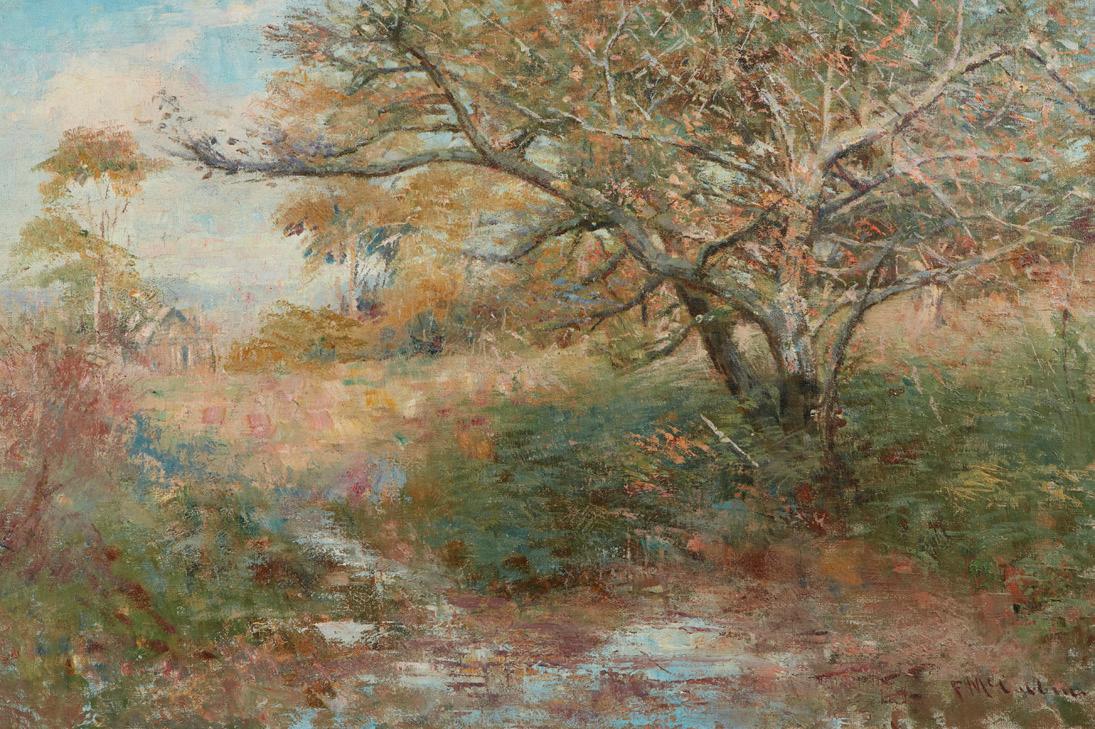

20
RUPERT BUNNY (1864-1947)
Portrait de Mme B... c.1914
(also known as Portrait of the Artist’s Wife) oil on canvas
signed lower left: Rupert C W Bunny
217 x 107.5cm
provenance
Mrs J. S. Reid (née Hilary Mackinnon), Victoria, the Artist’s niece
Private collection, London
Joel Fine Art, 2007
Private collection, Western Australia
exhibitions
Société Nationale des Beaux Arts, Lyon, 1914, cat. no. 186
Paintings by Rupert Bunny from Private Collections, McClelland Gallery, Victoria, 25 November 19728 February 1973, cat. no. 21 (as “Portrait of the Artist’s Wife”)
literature
Le Temps, Paris, 12 April 1914, p. 5 (as “Portrait de Femme en Bleu”)
Journal des Debats, Paris, 12 April 1914, p. 4
The British Australasian, London, 14 May 1914, p. 13
Thomas, D., Rupert Bunny 1864-1947, Lansdowne Press, Melbourne, 1970, cat. no. O162 (as “Portrait of the Artist’s Wife”)
Thomas, D., The Life and Art of Rupert Bunny: A Catalogue Raisonné in Two Volumes, Thames & Hudson, Melbourne, 2017, vol. 2, p. 46, cat. no. O320
$300,000-400,000
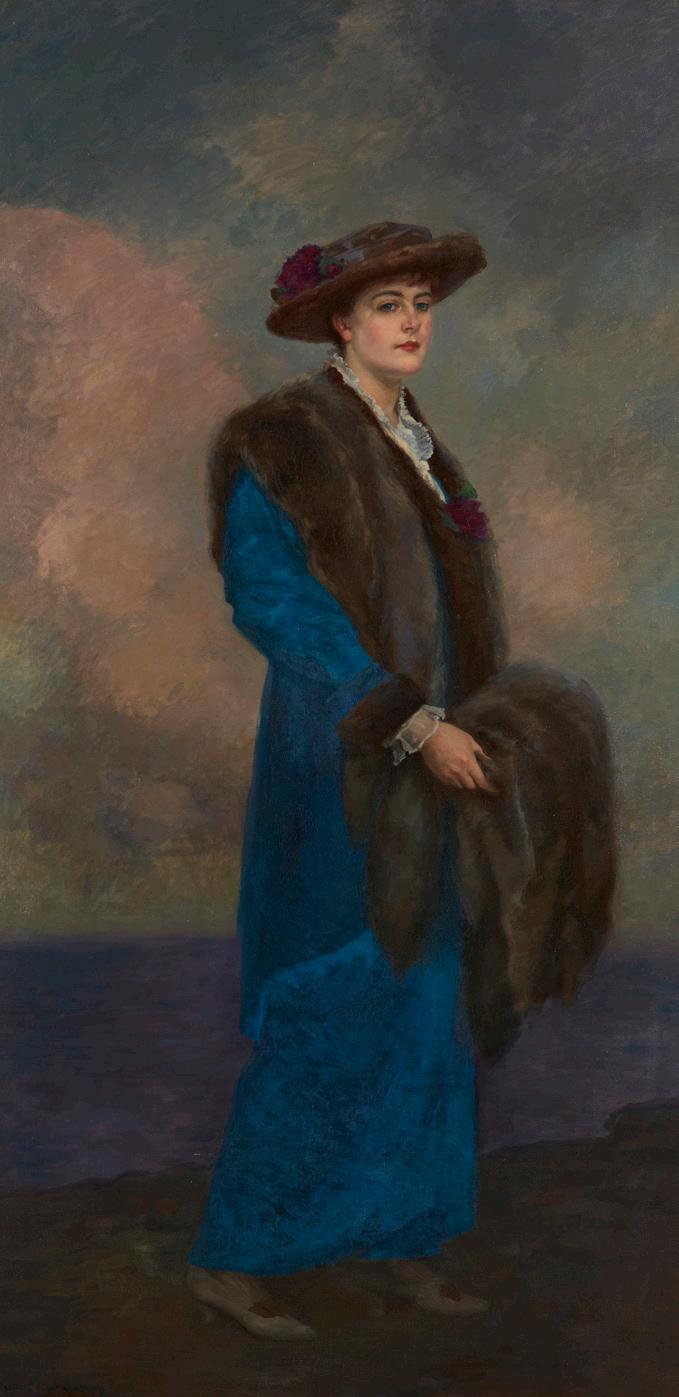

21
WILL ASHTON (1881-1963)
(The Bridge Over the Seine, Paris) oil on canvas laid on board
signed lower right: WILL ASHTON.
36 x 43.5cm
provenance
Leonard Joel, Melbourne, 12 April 2006, lot 646
Private collection, Western Australia
$4,000-6,000
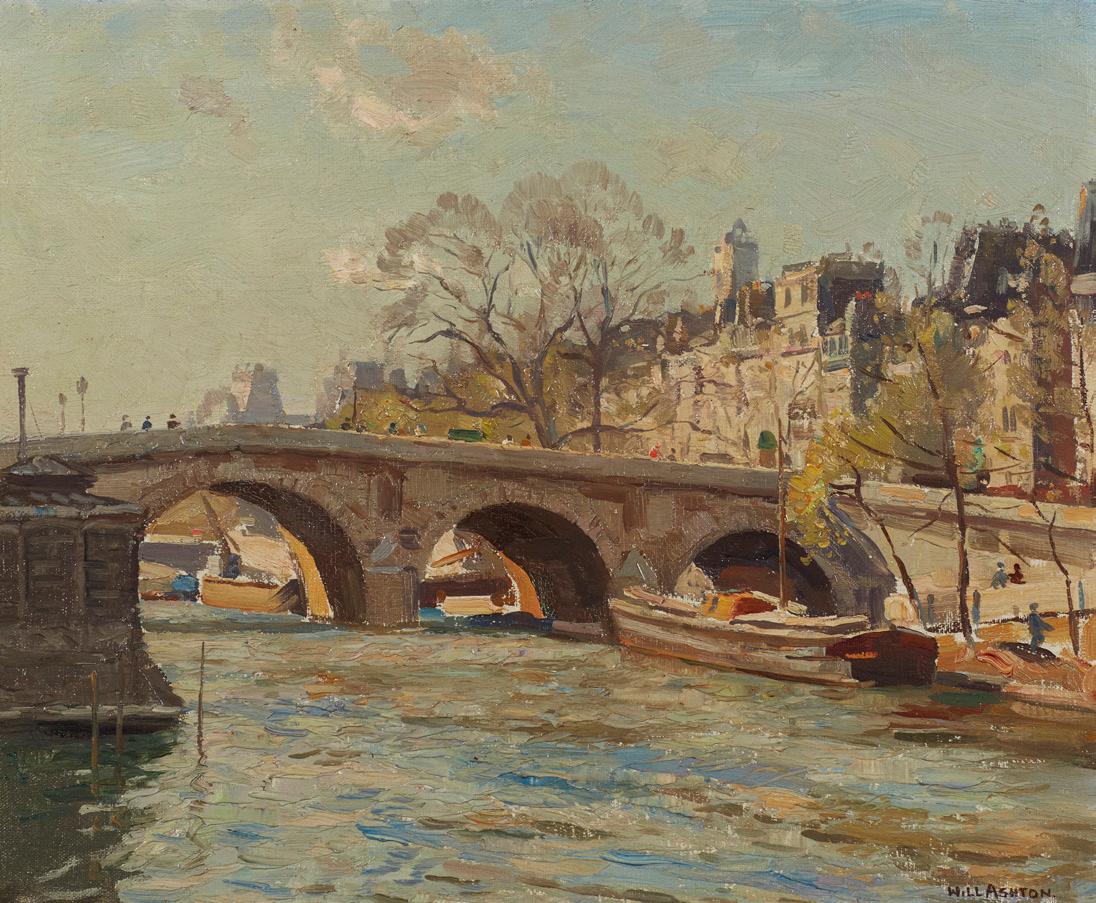

22
ARTHUR STREETON (1867-1943)
Ramparts Face the Ocean 1932 (also known as Southern Ocean) oil on canvas signed lower left: A. STREETON. inscribed on stretcher bar verso: Southern Ocean Pt. Campbell inscribed verso: Bill Stephen in appreciation of his services to Lorida 50 x 75cm
provenance
David Jones Gallery, Sydney (partial label verso) Earl Gallery, Geelong 1978 Private collection, Sydney
Sotheby’s, Sydney, 15 August 2000, lot 35 (as “Southern Ocean, Port Campbell”) Private collection, Western Australia
exhibitions
Exhibition of Paintings by Arthur Streeton, Fine Arts Gallery, Melbourne, 31 March - 14 April 1932, (as "Ramparts Face the Ocean")
(possibly) A Retrospective Exhibition of Paintings by Arthur Streeton, Athenaeum Gallery, Melbourne, 1526 August 1933, cat. no. 7 (as "Southern Ocean")
Exhibition of Oil Paintings by Arthur Streeton, Athenaeum Gallery, Melbourne, 10 - 22 June 1935, cat. no. 12 (as "Southern Ocean")
Exhibition of Pictures by Sir Arthur Streeton, David Jones Gallery, Sydney, April 1937, cat. no. 10 (as "Southern Ocean")
Arthur Streeton and the Australian Coast, MPRG Mornington Peninsula Regional Gallery, Mornington, 11 December 2004 - 6 March 2005, exhibition curators: Geoffrey Smith and Oliver Streeton, cat. no. 53 (as "Ramparts Face the Ocean")
Land of the Golden Fleece - Arthur Streeton in the Western District, Geelong Gallert, Geelong, 27 February - 13 June 2016, cat. no. 20 (as "Ramparts Face the Ocean")
$150,000-200,000
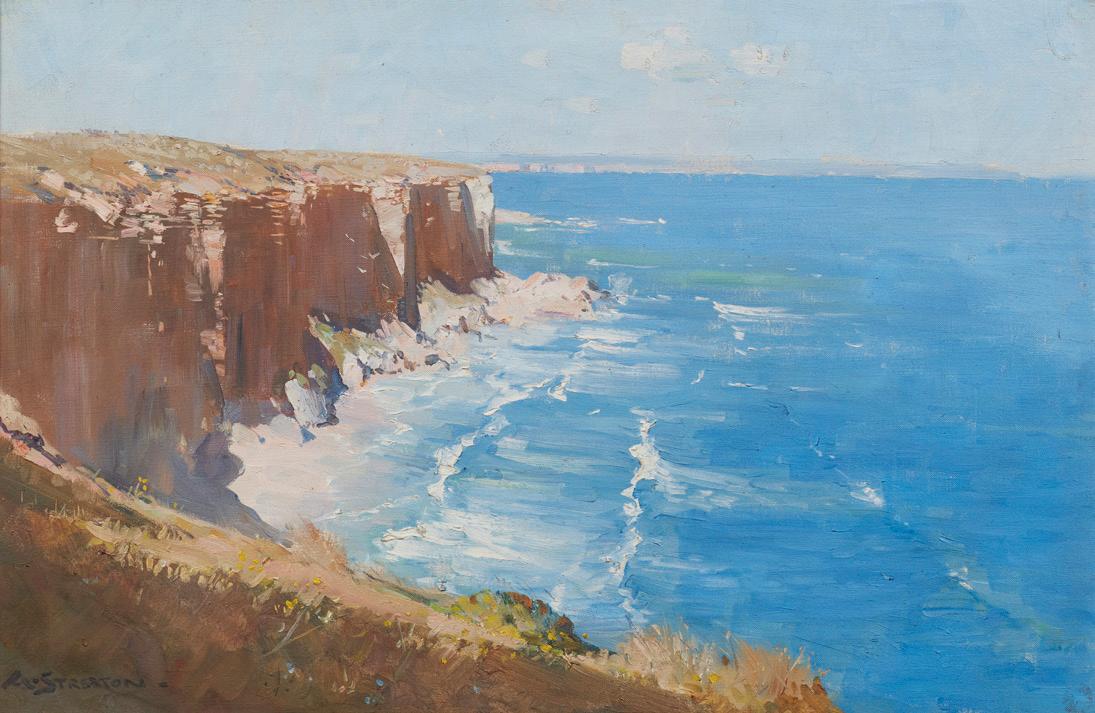
Arthur Streeton
Sir Arthur Streeton (1867–1943) is one of Australia’s most influential artists, celebrated for his masterly use of tone, colour and light in capturing the atmosphere and mood of the Australian landscape. A prominent figure in Melbourne’s 1880s avant-garde, Streeton shaped the visual language of the Australian national imaginary at the dawn of Federation.
Born in Mt Duneed, on the outskirts of Geelong, and raised in Melbourne, Streeton began his career at fifteen when he enrolled in night classes at the National Gallery School, where he studied drawing from 1882 to 1887. Streeton’s interest in the temporal qualities of the landscape is evident in his earliest paintings, Sandridge (1884) and Harbour Scene (1884), sketched while captivated by the movement of ships and sailors arriving in Hobson’s Bay as he delivered cheques to the docks at Sandridge while working as a young clerk at Rolfe and Co. Ltd.
Without formal training in painting, Streeton’s friendships within the bohemian circles of ‘Marvellous Melbourne’ offered the young artist the critical dialogue and camaraderie essential for his artistic growth. Frederick McCubbin (1855-1917), an instructor at the National Gallery School, became a key mentor to the young artist and was the first to encourage Streeton to start using oil. Both Streeton and McCubbin were members of the Bohemian Sketching Club, which was founded at a Richmond bookstore with artists Louis Abrahams (1852-1903) and Emanuel Phillips-Fox (1865-1915) in 1884. On weekends, the artists would travel to Ivanhoe and Templestowe on the outskirts of Naarm/Melbourne to paint from nature.1
Another formative influence was Tom Roberts (1856-1931), who brought the principles of Naturalism and Aestheticism to the colonies after studying at London’s Royal Academy.2 Streeton and Roberts met by chance while painting en plein air at Rickett’s Point, Mentone, during the summer of 1886, sparking a lifelong friendship based on shared artistic ambition. Streeton joined Roberts and McCubbin at the Box Hill artists’ camp, where he painted Settler’s Camp (1888) and Pastoral (1888). The sale of these works allowed Streeton to leave his lithography apprenticeship at Charles Troedel & Co. and focus on painting full-time.3
In 1888, Streeton established an artists’ camp at Eaglemont, where he was joined by Roberts and the young artist Charles Conder (1868-1901), who had arrived in Naarm/Melbourne from Warrane/Sydney. At Eaglemont, the artists experimented with tone and colour to capture the ephemeral effects of light at dusk. Streeton’s deep affection for these formative years in the artists’ camps was reflected in a letter to Roberts, written after he relocated to London in 1896:
‘… how far back it all seems, yet how clear—every detail and trifle engrained in my brain for life… The Creek, the horehound patch, the black wattle, the messmate, the long open space up to the road, the hurrying up the hill on Sunday evenings with Prof [McCubbin] well to the fore: Heidelberg, the she-oak and sienna dust all over; the straw brown hills; pale Dandenongs… All the loveliness—all a dream!’4
It was from these paintings created at the artists’ camps in the late 1880s that Streeton, Roberts, Conder, and McCubbin became known as the Heidelberg School. Their experiments culminated in the ‘9 by 5 Impression Exhibition’, held at Buxton’s Rooms on Swanston Street in August 1889, after which the close working relationship between the quadrumvirate ended. Conder left for Paris, McCubbin stayed in Melbourne, and Streeton and Roberts joined the Curlew artist colony at Goram Bullagong, where they began their search for a ‘national image’.5
1. Ann Galbally, Arthur Streeton (Lansdowne, 1969): 11
2. David Hansen, ‘Naturalism and nationalism: the reception of Arthur Streeton, past and present,’ Times Literary Supplement , (no. 6159, 16 April 2021): 14
3. Galbally, Arthur Streeton, 14
4. Smith, Australian Painting, 152
5. Ian McLean, Double Nation: A History Australian Art (Reaktion Books, 2023): 83
In Sydney, Streeton’s earlier studies of light, characterised by high-key blue and gold tones and thick impasto brushwork, developed into a more monumental style of painting that aligned with the nationalist ideals of pastoral settlerism. As Ian McLean points out, it was in Sydney that Streeton achieved his breakthrough, ‘combining the wide, high-horizon format’ with a ‘vertical movement’ that guides the eye up the foreground ‘into the glowing band of sky’ in the background.6 Streeton’s heroic new style is exemplified in 'The purple noon's transparent might' (1896), which he painted over two days in a ‘trance-like state’ at the foothills of Colomatta on Dharug Country.7 In 1916, McCubbin referred to this work as a ‘national symbol’.8 Following his first solo exhibition in Melbourne, 'The purple noon's transparent might' was acquired by the National Gallery of Victoria in the same year it was painted, providing Streeton the financial means to undertake what had become a rite of passage for many Australian artists of the time: travelling to the ‘Centre of the Empire’ at age thirty. Arriving in 1897 after a 5-month visit to Cairo, Streeton’s early years in London were ‘the most difficult of his life.’9 Although Streeton had established himself as an Australian painter when Golden Summer, Eaglemont (1889) was exhibited ‘on the line’ at the Royal Academy in London in 1891, receiving an honourable mention the following year at the Paris Salon, he was eager to outgrow his reputation as a colonial artist. Poor and lonely, he immersed himself in his practice, writing to Roberts: ‘I feel convinced that my work hereafter will contain a larger idea and quality than before, after seeing Constable, Turner, Titian, Watts and all the masters.’10 Upon discovering that the value of his work had significantly increased over the eight years since he left Australia, his outlook became more optimistic. Streeton returned to Australia in 1906 to build on this momentum, and with the backing of his patron Baldwin Spencer, he organised three successful solo exhibitions in Melbourne and Sydney in 1907.11 On his return to London via Italy, Streeton began to garner critical attention from local critics. Writing about his Venetian landscapes, a critic in The Observer noted that ‘...The fact remains that Mr Streeton has caught the opalescence and glitter of the Venetian canals and marble palaces in moments of bright sunshine as few artists have done before him...’12
Streeton began building a network of patrons, notably with industrialist Ludwig Mond, who purchased The Grand Canal, Venice (1908) in 1909, and with whom Streeton formed a particularly strong connection. He was introduced to Mond by the Canadian violinist Nora Clench (1867-1938), whom Streeton married in 1908. In May 1913, the Mond family commissioned Streeton to produce a series of twelve to fifteen garden landscapes in Kent, where he travelled with Nora and their young son, Charles Ludwig Oliver Streeton (1911-1977), who was named after the Mond patriarch.13 The Rose Garden (1913) (Lot 18) belongs to this series, in which Streeton uses the same vertical format characteristic of his monumental bird’s-eye-view landscapes. The composition guides the viewer’s eye from the garden foreground, through the trees, and into an iridescent, golden-blue sky, reminiscent of the intensity of the Australian heat captured in 'The purple noon's transparent might'. Another work from this series is The Lake, Coombe Banks, Surrey (1913), held by the National Gallery of Victoria.
Streeton stayed in London for 20 years, regularly sending artworks to Australia, before returning permanently in 1923.14 When he arrived, he was the ‘patriarch of national art.’15 If Streeton’s early works, painted in the artists’ camps, express the restlessness of youth in his pursuit of a ‘national picture’, his later works of the Victorian countryside demonstrate his achievements, having cultivated national icons from the expansive plains and vast coastlines.
6. McLean, Double Nation, 86
7. McLean, Double Nation, 83
8. Frederick McCubbin, The Art of Frederick McCubbin, 1916, in Smith, ed., B., 1975, 274-275
9. Bernard Smith, Australian Painting 1788–1960 (London: Oxford University Press, 1926): 150
10. Galbally, Arthur Streeton, 47
11. The first was held in the Guildhall in Melbourne, April 1907, the second at Market Buildings, Sydney, July 1907; and the final at Bernard’s Gallery, Melbourne, October 1907, which sold out in 5 days.
12. Galbally, Arthur Streeton, 71
13. Galbally, Arthur Streeton, 76
14. In 1918, he was appointed as an official war artist, travelling to the Western Front to depict the destruction of war in France and Belgium.
15. McLean, Double Nation, 124
Free to finally immerse himself in the landscapes he longed for while in England, Streeton travelled across Victoria to paint popular destinations. Critic Noman Lilley described his trip to Port Campbell in early 1932 in the Argus as particularly ‘rich in results.’16 Among the works produced was Southern Ocean, Port Campbell (circa 1932) (Lot 22). Executed in Streeton’s characteristic style, with a high horizon line and vivid contrast between the luminous blue ocean and sunlit orange cliffs, the painting reflects Streeton’s deep intimacy and affection for coastal landscapes he described in his correspondence with Roberts:
‘The ocean is a big wonder, Bulldog. What a great miracle. It’s hard to comprehend it, like death and sleep. The slow, immense movement of this expanse moves one very strongly. You’re made to clutch the rocks and be delighted, a dreadful heaving and soft eternity.’ 17
Unlike his earlier depictions of the oppressive stillness of drought-affected inland landscapes, Southern Ocean, Port Campbell (Lot 22), conveys a sense of optimism and stability that aligns with the mood of regional landscape painting popular during the interwar period. When Streeton exhibited his Port Campbell paintings at the Fine Arts Gallery in April 1932, George Bell praised the ‘flowing ease of accomplishment’ of his ‘sunlit seascapes.’18 The positive reception was echoed by Harold Herbert, who wrote in The Australasian:
‘Technically perfect, they glitter with light and atmosphere. Those red-yellow cliffs of that part of the coast are extremely difficult to paint…Streeton has done it… the undeniable truth remains that Streeton is our greatest landscape painter.’19
Alongside his coastal vistas, Streeton exhibited paintings of his beloved gardens at Altadore, his Toorak home and Olinda, his homestead in the Dandenong Ranges. An enthusiastic gardener, Streeton’s interest in floral landscapes evolved following his marriage to Nora.20 Madonnas in a Garden (Lot 3) depicts his garden at Altadore. A row of Madonna lilies, painted with quick brushwork and dappled with sunlight, rise from the lush green foreground into the middle ground. Their white petals contrast with the majestic olive tree, guiding the eye upward to a luminous sky of Streeton’s iconic blue, which captures the fleeting brightness of midday light.
In 1929, Streeton became a critic for the Argus and was knighted for his services to art in 1937. For the remainder of his life, he split his time between Altadore and Olinda, nurturing his connection to his home as an artist, tastemaker, and gardener.
dr suzannah henty
Dr Suzannah Henty is the Hugh Ramsay Postdoctoral Fellow at the University of Melbourne, where she also teaches art history.
16. Norman Lilley, ‘Mr Streeton’s Mastery: Bush, Sea and Flowers, work of charm exhibited,’ The Argus, March 31, 1932, 8
17. Letter to Tom Roberts, quoted in Croll, R. H., Tom Roberts: Father of Australian Landscape Painting, Robertson and Mullens, Melbourne, 1935, 9
18. George Bell, ‘Sunny Costal Scenes,’ The Sun News-Pictorial, 31 March 1932, 11
19. Harold Herbert, ‘Mr Arthur Streeton’, The Australasian, 22 June 1935, 16
20. Streeton loved lilies. In London, he grew Golden-rayed Lily (Lilium auratum) in the small garden of their St John’s Wood home, which he painted in Lilium auratum (c.1909), now held in the Art Gallery of New South Wales. After returning to Australia, he continued to grow Madonna Lily (Lilium candidum), Regale Lily (Lilium regale), and Tiger Lily (Lilium lancifolium) in Toorak and Olinda.


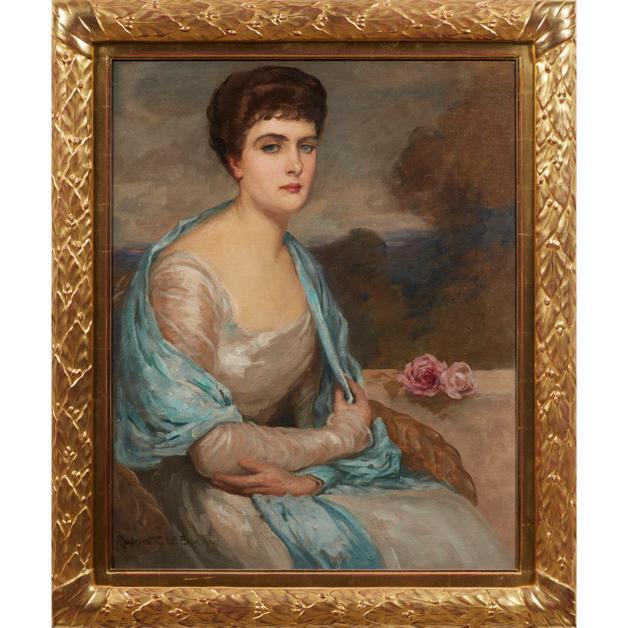
23
RUPERT BUNNY (1864-1947)
Portrait of Mme B c.1903 oil on canvas signed lower left: Rupert C W Bunny. partial unknown label on stretcher bar verso (illeg.) 79.5 x 63.5cm
provenance
The F. Behan Collection, Melbourne
Joel Fine Art, Melbourne, 30 October 2007, lot 35A
Private collection, Western Australian
exhibitions
Exposition de Monsieur Rupert C.W Bunny, Galerie Silberberg, Paris, 6 - 26 May 1903, cat. no. 5
Salon d’Automne, Paris, 31 October - 6 December 1903, cat. no. 102
Exposition Rupert Bunny, Henry Graves and Co Ltd, Paris, 3 - 18 March 1905, cat. no. 2 (as “La Femme à l’Écharpe Bleue”)
literature
Studio, London, vol. XXIX, August 1903, p. 218
Bouyer, R., Expositions et Concours - Rupert Bunny, Le Bulletin de l’Art Ancien et Moderne, Paris, no. 251, 11 March 1905, p. 77
Gérard-Austin, A., The Greatest Voyage: Australian Painters in the Paris Salons, 1885-1939, doctoral thesis, Universite Paris 1 - Pantheon-Sorbonne, March 2014, vol. 2, pp. 16, 79, 123 (illus.)
Thomas, D., The Life and Art of Rupert Bunny: A Catalogue Raisonné in Two Volumes, Thames & Hudson, Melbourne, 2017, vol. 1, p. 117 (illus.), vol. 2, p. 33, cat. no. O199
$100,000-150,000


24
CHARLES CONDER (1868-1909)
(The Introduction) c.1905 oil on canvas signed lower left: C. CondeR
62.5 x 74.5cm
provenance
The Collection of Kurt Albrecht, Melbourne
Thence by descent
Kozminsky Galleries, Melbourne
Private collection, Western Australia
$25,000-35,000


25 HANS HEYSEN (1877-1968)
Study for The Coming Home c.1904
oil on canvas laid on masonite
30.5 x 54.5cm
provenance
The Collection of Mrs S J Bannon
GFL Fine Art, Perth, 25 May 1999, lot 80
Private collection, Western Australia
GFL Fine Art, Perth, 28 November 2000, lot 38
Private collection, Western Australia
related work
The Coming Home 1904, oil on canvas, 106.4 x 184.5cm, the Collection of Art Gallery New South Wales, Sydney (acquired in 1904)
‘Hans Heysen’s choice of subject in ‘The Coming Home’ reflects his love and reverence for nature and rural life. He took inspiration from the landscape and labours of local farmers near his home in Adelaide and, later, Hahndorf in the Adelaide Hills. Suffused with golden light, this gentle image of cattle being herded evokes a European pastoral ideal. Made soon after his studies in Paris at the turn of the century, it reveals the influence of the work of John Constable and the painters of the French Barbizon school, whom Heysen particularly admired.’ (Art Gallery of New South Wales, Sydney)
other notes
This work is a study for the major oil painting ‘The Coming Home’ 1904 that is in the Art Gallery of New South Wales, Sydney collection and was acquired in 1904. The major work was purchased by the Trustees from the Annual Exhibition of the Royal Art Society of New South Wales, where it was listed as catalogue number 80 and priced at 150 guineas.
$30,000-40,000

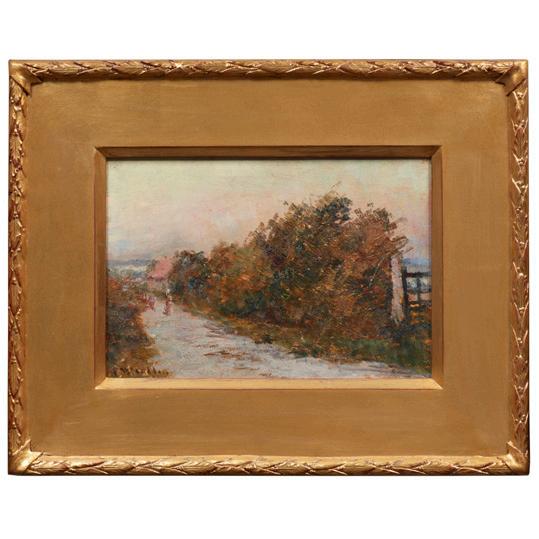
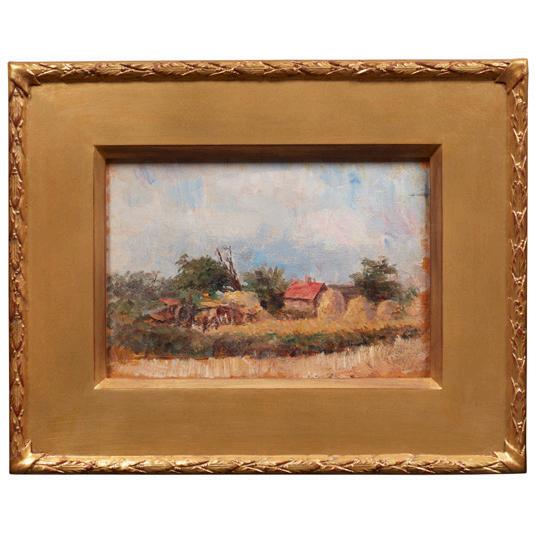
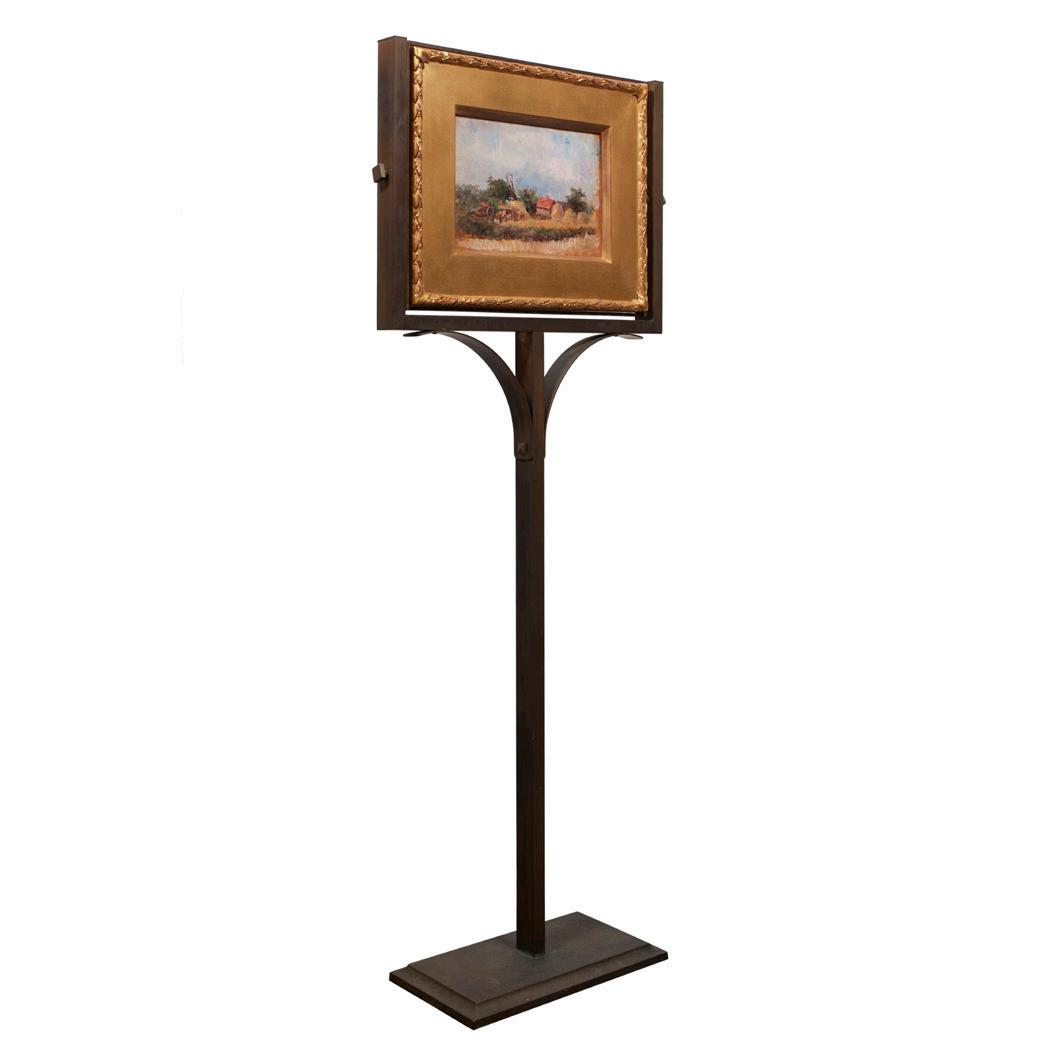
The Country Lane Farm House (verso) oil on board, double-sided in a custom made frame stand signed lower left: F. McCubbin 23 x 33.5cm
provenance
Mrs Alexander, student of the Artist Thence by descent Christies, Melbourne, 8 May 2001, lot 134 Private collection, Western Australia $25,000-35,000
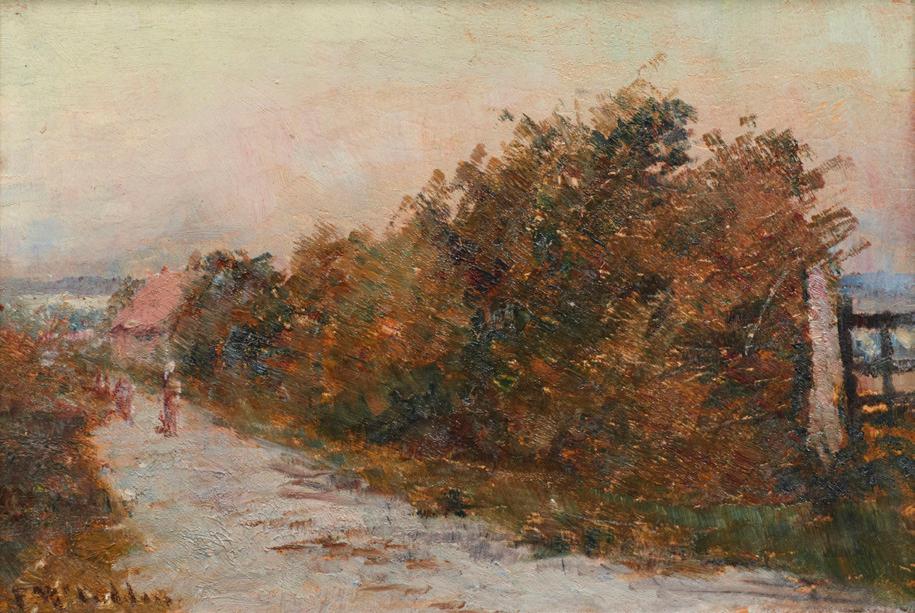

Frederick McCubbin
Frederick McCubbin (1855-1917) was among a group of painters of the Australian scene now known as the ‘Heidelberg School’. At art school they had been introduced to the landscape painter’s craft by Eugene von Guerard, who was fixated with technique; although he did inspire the students to go sketching in bushland at Studley Park. ‘For the first time I was awakened to the beauties to Australian landscape,’ McCubbin always recalled of that afternoon. Painting together on their bush camps, from the late 1880s these artists reached high levels of achievement by combining aspects of rural life, open-air naturalism, and certain impressionist values.
Where others in the ‘Heidelberg School’ initially excelled painting rural views and sun-drenched vistas, McCubbin gain attention with pictorial statements using a figure or two in secluded bush settings. His celebrated ‘big pictures’ Lost (1886), Down on His Luck (1889) and On the Wallaby Track (1896) were dramas of human struggle in an untamed land. But these shady forest scenes exuded a strong affinity for nature, indeed, the Argus newspaper suggested each of his intimiste pictures of Victorian bush amounted to ‘a little poem without words.’ There was a poignant beauty to McCubbin’s delicate tracery of gum leaves and twiggy branches, of gentle saplings and dry grasses.
Roberts, Streeton and Conder subsequently left the colony, adopting a cosmopolitan twang when painting in Europe. However, McCubbin accepted a coveted teaching position at the National Gallery School and stayed put in Melbourne. Setting aside story-telling, he would henceforth channel his energies into consciously Australian compositions which imbibed nature with a moody veracity.
McCubbin adopted a disciplined work pattern from the late 1890s. If he resided in Melbourne during the teaching week, much painting time was spent an hour’s train journey north of the city at Mt Macedon, where the artist established himself in ‘Fontainebleau’ cottage. The spacious studio there was where his finest work was lovingly crafted.
Bush Study, Macedon (Lot 30) is among a series of bushland images McCubbin made of the mountain’s upper slopes. With short, loosely pulled strokes and small paint dashes, it shows a section of virgin forest touched by a previous bushfire. Looking through packed timbers we see the trunk of a sturdy eucalypt rising in full sunlight, although it is screened by the scorched limbs of an adjacent dead tree, while other saplings around bear sprays of green growth.
The Macedon locality offered a multitude of natural settings, McCubbin choosing varied subjects on regular rambles there. Sure enough, the artist draws the viewer’s attention to a different aspect of nature with a stunted eucalypt in Mount Macedon (Lot 19). It is set on a sunny day just before the onrush of spring. With a bed of bracken at its base, the scrawny tree is by a grassy walking track between the railway station and scattered houses at Macedon. Taking obvious delight in its random growth, the artist has fastidiously recorded this dense tangle of dead lichen-covered branches to the front, and verdant young boughs behind, which have flourished for untold years.
Another aspect of nature is handled in Bush Setting, Mount Macedon (Lot 28) where dark forest rises over the trickling beck that supplied water behind a cottage (hence the large tub). Much is carried in these works by the tasty brushwork, indeed, the artist wanted the viewer to lean in close and savour his paint skin. McCubbin excelled at what conservators term his ‘opalescent’ illumination, crafting layers of oil pigment shot through with jewel like colours. This was made by applying multiple notes of paint with small brushes he trimmed to shape, and tiny scrapers he made himself. The finished picture may be small, but up close it is selfevidently intense, each tiny note enabling the artist to work with shimmering divided colours.
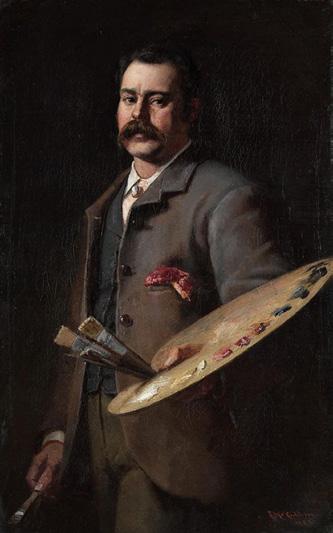
A break in McCubbin’s oeuvre occurred in 1907 when he took several months leave to travel overseas. He sailed for Britain where he based himself in London, meeting up with old friends, and making excursions to France and Italy to see the sights and visit great museums, intently studying Old Master works. This would be his only trip abroad.
Hammersmith Bridge (Lot 9) and The Country Lane (Lot 26) are products of that trip. Both painted on prepared panels, one is a quick oil sketched by the Thames in west London, whereas the latter is a considered—and more deftly worked—view of a profuse hedgerow encountered in the English countryside. Ever fascinated by nature, McCubbin strives to convey the persona of this unfamiliar landscape while knitting spicy strokes in his characteristic paint skin.
Upon his return to Melbourne, the artist increasingly painted everyday corners of Prahran and South Yarra. Towards Prahran (Lot 16) shows a long brick wall, over which we glimpse the tops of shrubs in a domestic garden, and a slender sight of the distant inner suburb. Yet again the motif serves as an avenue into visual enjoyment, observed facts giving way to a multitude of glistening dabs and buttery scuffs of pigment.
Figures in Street, A Bit of South Yarra (Lot 29), a contemporaneous work, is an accomplished oil sketch of pedestrian traffic. It is evident McCubbin has absorbed Monet on his overseas travels, but this is an impression in his own painterly terms, using brush and scrapers to summarise figures.
In 1909 McCubbin purchased ‘Carlesberg’, a colonial period house at the end of Kensington Rd, South Yarra. Bordered by the Como Estate, it came with 3½ acres of informal garden which directly overlooked the river. The views from, and trees within, that sloping garden supplied subjects for his very late canvases.
With a deliberately diffuse paint application Artist’s Garden, South Yarra (Lot 13) is a lovingly crafted view of melaleucas along a fence. All is stillness and lyrical beauty in this secluded corner of the artist’s garden, a slice of nature he identified with. Shown on a frosty winter morning, this is late McCubbin at his very finest.
The Lime Tree (Yarra from Kensington Rd) (Lot 10) is the last painting McCubbin completed. Much is packed into this composition, which offers another tree, a glimpse of the Yarra River and of suburban Richmond beyond, as well as the artist’s signature paintwork. Knowing he was mortally ill, McCubbin chose to make a final work showing the mature Linden tree in his garden when it was covered in new spring leaves on a warm day—a symbol of nature’s regeneration.
dr christopher heathcote
Christopher Heathcote (PhD) is an author of several books, art critic, and authority on Australian art. In a chequered career he has been senior art critic for The Age, associate editor of Art Monthly Australia, an academic at La Trobe and Melbourne Universities then the Victorian College of the Arts, a curator of exhibitions at regional galleries and Canberra’s National Gallery, as well as head of the Gordon Institute’s art school.

27
TOM ROBERTS (1856-1931)
Violet Bancroft 1914 oil on canvas
signed and dated lower left: Tom Roberts /14’ 74.5 x 62cm
provenance
The Collection of Mrs Henson Bancroft, England
Thence by descent
Private collection, Melbourne
Leonard Joel, Melbourne, 27 June 2010, lot 111
Private collection, Western Australia
literature
Topliss, H., Tom Roberts 1856-1931: A Catalogue Raisonné, Oxford University Press, Melbourne, 1985, vol. I, p. 189; vol. II, pl. 196, cat. no. 466 (illus.)
Cotter, J., Tom Roberts & the Art of Portraiture, Thames & Hudson, Port Melbourne, 2015, pp. 318-28 (illus.), fig. 6.46
other notes
The sitter was the youngest daughter of Mrs Henson Bancroft who was a cousin of Tom Roberts. Roberts painted Mrs Henson Bancroft in 1914 in Widow’s Weeds after the death of her husband Henson Bancroft and also painted her children in the same year.
$25,000-35,000

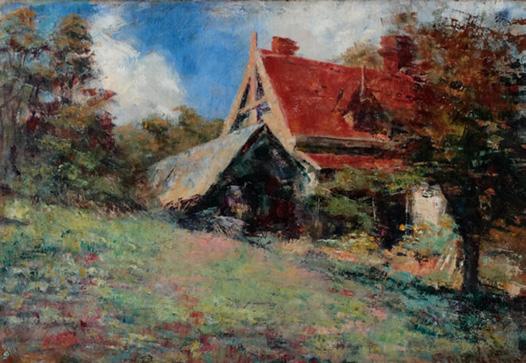

28
FREDERICK MCCUBBIN (1855-1917)
(Bush Setting, Mount Macedon) 1902 oil on canvas
signed and dated lower left: F.McCubbin/ 1902 artist’s name and title on gallery label verso 39.5 x 60cm
provenance
Leonard Joel, Melbourne, 28 July 1998, lot 55A (as “Water Barrel”)
Private collection, Melbourne
Kozminsky Galleries, Melbourne (as “Bush Setting, Mount Macedon”) (label verso)
Private collection, Western Australia
exhibitions
Spring Exhibition, Kozminksy Galleries, Melbourne, 1998, cat. no. 9 (as “Bush Setting, Mount Macedon”) (label verso)
Spring Exhibition, Kozminksy Galleries, Melbourne, 2000 (as “Bush Setting, Mount Macedon”) (label verso)
other notes
Frederick McCubbin’s deep connection to Mount Macedon is evident in the number of works he produced in and around the area from the early 1900s until his death in 1917. In 1901, McCubbin purchased a cottage named ‘Fontainebleau’ in the Macedon Ranges, which became a retreat for the artist and his family. The name ‘Fontainebleau’ was influenced by the forest near Paris where the Barbizon School painters had worked and sought inspiration in the mid nineteenth century. This French school of painting was part of the larger European movement towards naturalism in art which led to the establishment of Realism and influenced the young Impressionist artists. Surrounded by dense bushland, towering gums trees and dappled sunlight, the region provided McCubbin with a new sense of tranquillity and inspiration, shifting his palette towards more atmospheric and impressionistic tones.
The Macedon Ranges became an importance place to the McCubbin family and a source of great inspiration to Frederick. McCubbin’s daughter Kathleen, wrote that her father’s ‘greatest love was the bushland at Mt Macedon. The mystique of the Australian bushland intrigued him: the sunlight glinting through the tall timbers, the secret colours in the abundant undergrowth, the call of the birds, and the whispering breeze’.1
At Mount Macedon, McCubbin moved away from the narrative compositions of his early career and embraced a more introspective and expressive response to the landscape. These later works are characterised by loose brushwork, a softened palette, and a poetic evocation of the Australian bush. Macedon offered McCubbin not only a physical escape from the city but also a profound emotional and spiritual connection to nature; a space where he could reflect, observe, and create.
Paintings from this period, often depicting the surrounding forests, ferns, and mountain air including one of his most famous works, the triptych The Pioneer 1904, mark a distinct chapter in McCubbin’s oeuvre and underscore his enduring legacy as a founding figure of Australian Impressionism.
1. Mangan, K., Daisy chains, war, the jazz, Hutchison, Melbourne, 1984, p. 70
$40,000-60,000

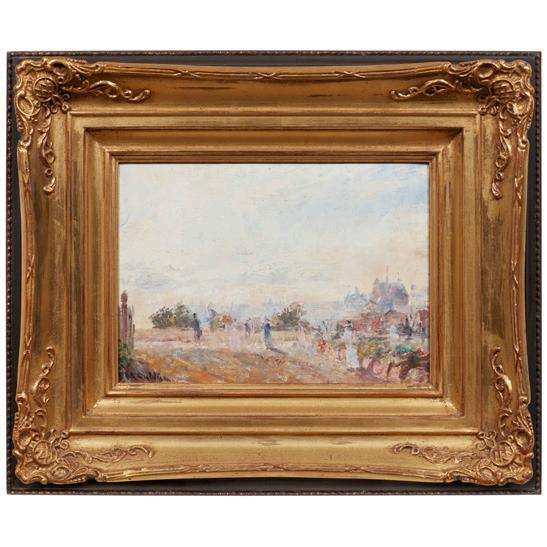
29
FREDERICK MCCUBBIN (1855-1917)
Figures in a Street - A Bit of South Yarra c.1910 oil on canvas
signed lower left: F.McCubbin
title inscribed verso: Figures in [sic]/ a bit of South Yarra 24 x 33cm
provenance
Private collection, Melbourne
Christies, Melbourne, 1 May 2000, lot 112 Kozminksy Galleries, Melbourne
Private collection, Western Australia
exhibitions
Winter Exhibition, Kozminsky Galleries, Melbourne, 2000, cat. no. 16
$25,000-35,000
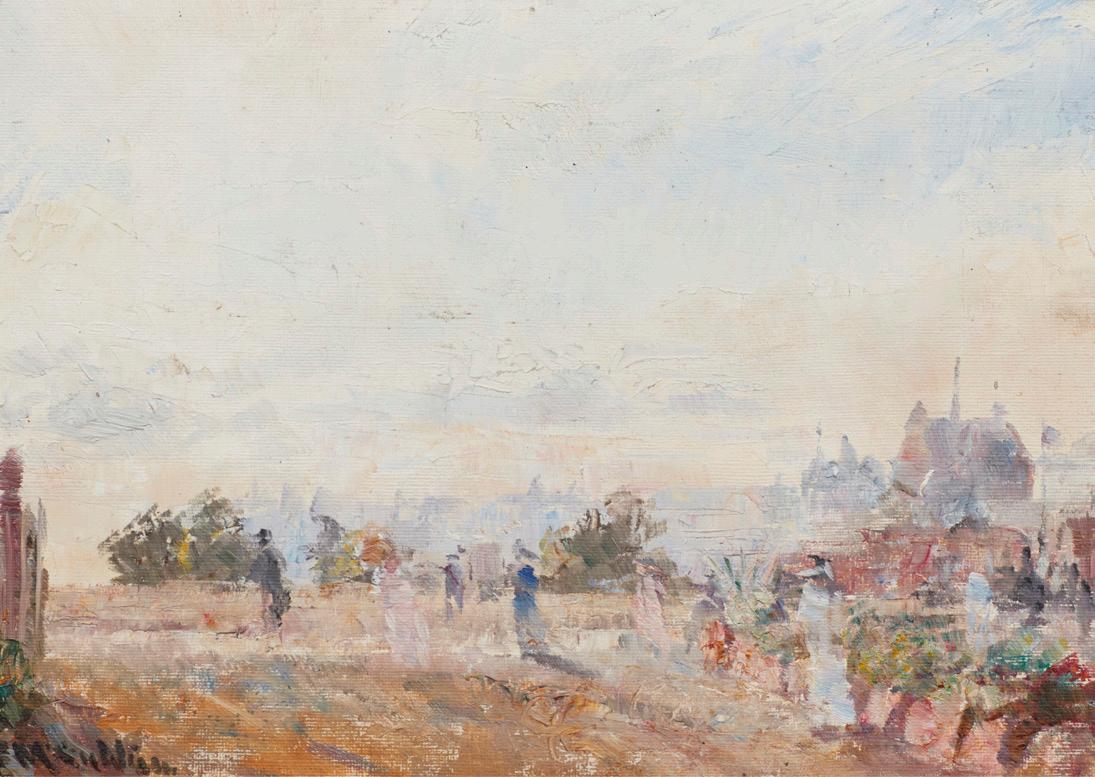
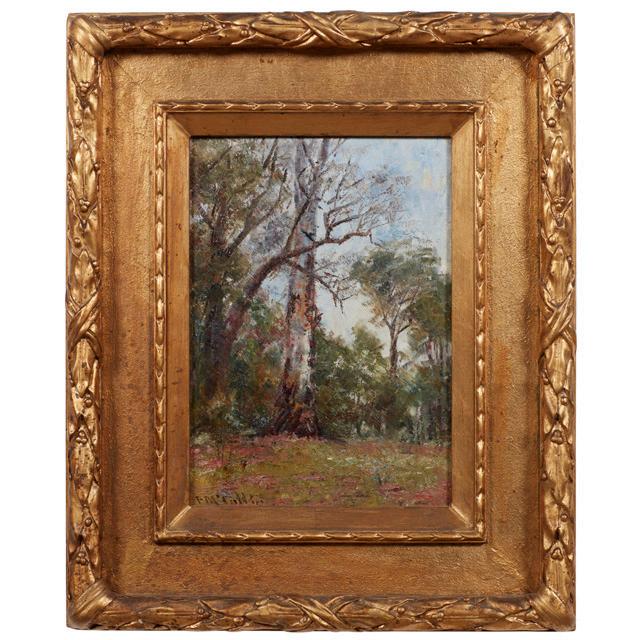
30
FREDERICK MCCUBBIN (1855-1917)
(Bush Study, Macedon) oil on board
signed lower left: F.McCubbin
35 x 25.5cm
provenance
(possibly) The Sedon Galleries, Melbourne (as “Bush Study”)
Private collection
Christies, Melbourne, 27 November 2000, lot 105
Private collection, Western Australia
exhibitions (possibly) Exhibition of Oils by the Late Frederick McCubbin, The Sedon Galleries, Melbourne, 9 September 1941, cat. no. 21 (as “Bush Study”)
$25,000-35,000
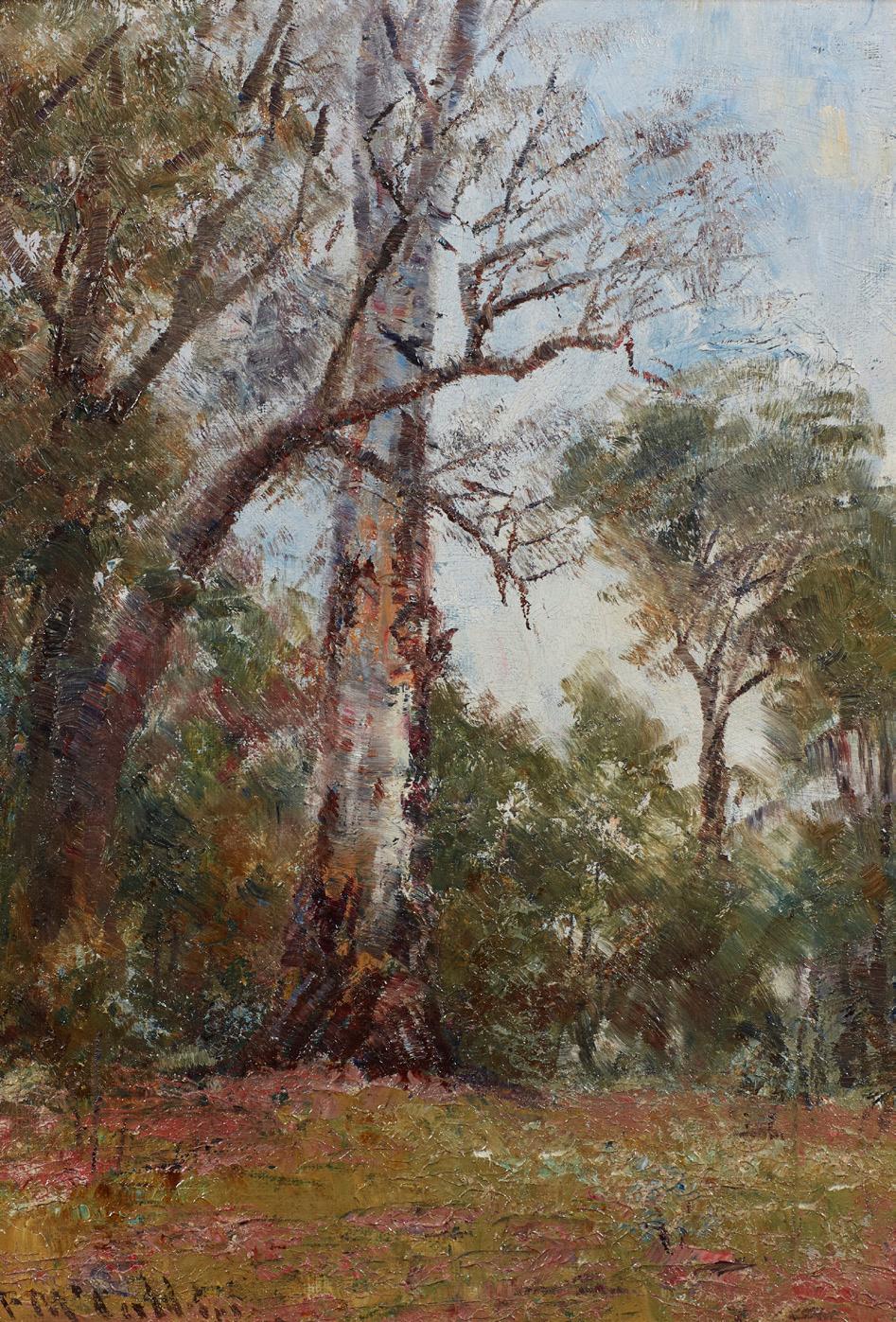
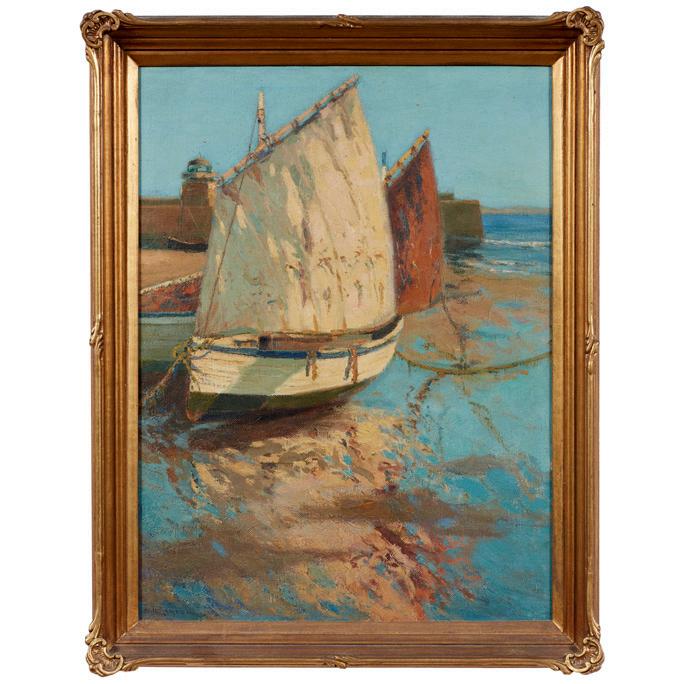
31 WILL ASHTON (1881-1963) (Boats on Shore) oil on canvas in the original John Thallon frame (partial label verso) signed lower left: Will ASHTON. 60 x 44.5cm
provenance
Private collection, Western Australia
$5,000-7,000



32
WEAVER HAWKINS (1893-1977)
Le Port 1924 oil on canvas
initialled and dated lower right: HWH/ ‘24
artist’s name and title inscribed verso: LE PORT/ Weaver Hawkins
52.5 x 70cm
provenance
Private collection, Melbourne
Leonard Joel, Melbourne, 8 November 1989, lot 200A
Private collection, Melbourne
Leonard Joel, Melbourne, 31 July 1990, lot 264
Private collection, Sydney
Sotheby’s, Sydney, 29 November 1991, lot 371
Private collection, Melbourne
Leonard Joel, Melbourne, 15 November 2000, lot 86
Private collection, Western Australia
other notes
“Well, I am primarily a classic artist, that is to say, what people call an intellectual artist, an architectonic worker”1 –Weaver Hawkins
Weaver Hawkins (1893–1977) was a British born Australian modernist artist, whose practice spanned painting, printmaking, and mural work. Hawkins work reveals a lifelong commitment to innovation and adaptability, despite great personal adversity. After sustaining serious injuries to his right arm during World War I, Hawkins taught himself to paint with his left hand, developing a distinctive graphic style characterised by rhythmic line work and expressive distortion. In the 1920s, he travelled extensively through Europe and the Pacific, producing a body of work influenced by Cubism, Futurism and Symbolism.
This artwork titled Le Port from 1924 is a luminous and harmoniously composed depiction of a sun drenched European harbour. Painted in soft, warm hues, the scene is animated by the gentle movement of moored sailing boats and the clustered buildings glowing in golden light that line the background. Hawkins masterfully captures the geometry of masts and rooftops, softened by atmospheric perspective and the dappled reflections dancing on the water’s surface. The arrangement of barrels on the docked boats suggests commercial activity, yet the scene remains serene and timeless. A departure from his later modernist abstraction, this earlier work reflects Hawkins’s time abroad and his command of light, colour, and classical balance.
1. Weaver Hawkins in Geoffrey Dutton, Artists' Portraits, National Library of Australia, Canberra, 1992, p. 68 $8,000-10,000
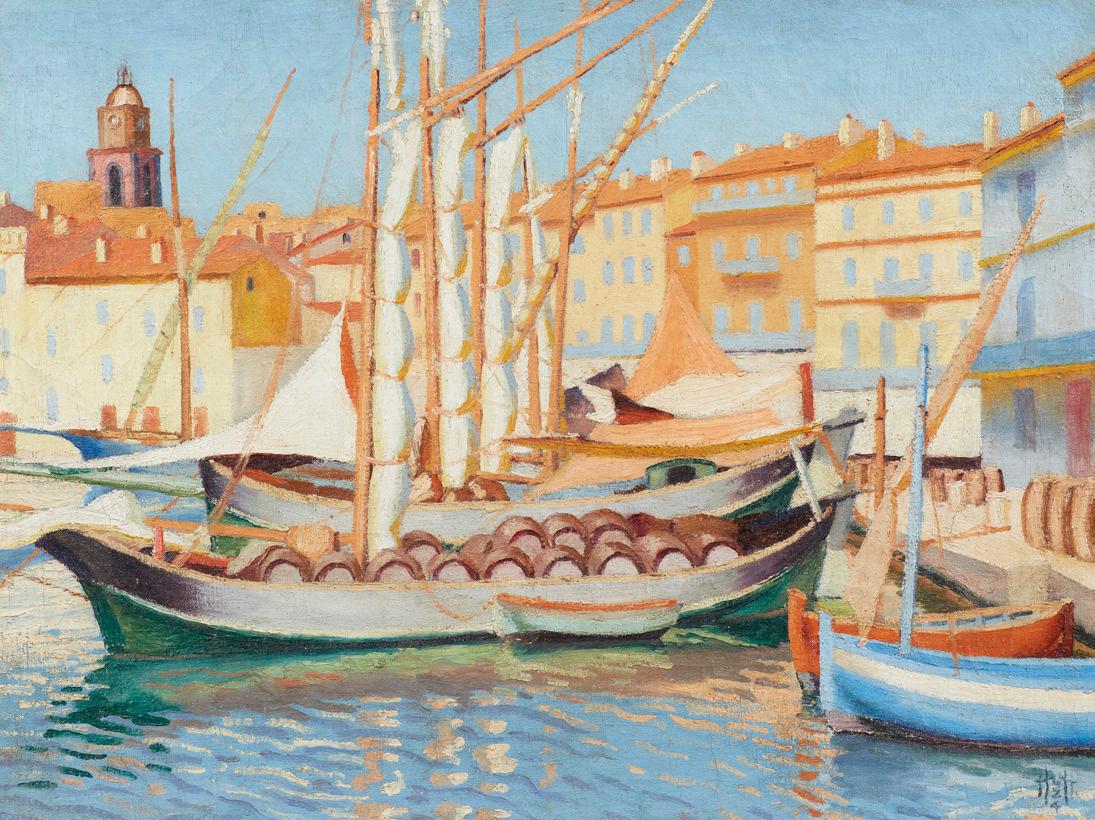

signed lower right: Arthur Boyd
39 x 59.5cm
provenance
The Estate of Alfred (Brough) Stevens, Melbourne
The Collection of Kurt Albrecht, Melbourne
Thence by descent
Kozminsky Galleries, Melbourne
Private collection, Western Australia
$4,000-6,000

Ashton, Will 5, 21, 31
B
Boyd Senior, Arthur Merric 33
Bunny, Rupert 4, 17, 20, 23
C
Conder, Charles 24
F Fox, Emanuel Phillips 2, 8, 11, 14 Fuller, Florence 1
H
Hawkins, Weaver 32
Heysen, Hans 25
M
Mccubbin, Frederick 9, 10, 13, 16, 19, 26, 28, 29, 30
R
Roberts, Tom 6, 12, 27
S
Streeton, Arthur 3, 7, 18, 22
W
Withers, Walter 15
opposite: lot 16
FREDERICK MCCUBBIN (1855-1917) Towards Prahran 1907 (detail) oil on canvas
22.5 x 53cm
$60,000-80,000
lot 6
TOM ROBERTS (1856-1931)
Dandenongs Landscape c.1924 oil on board
29 x 39.5cm
$80,000-120,000
lot 14
EMANUEL PHILLIPS FOX (1865-1915) (Place de la Concorde, Paris) c.1890 oil on panel
26 x 33.5cm
$30,000-40,000
back page: lot 20
RUPERT BUNNY (1864-1947)
Portrait de Mme B... c.1914 (also known as Portrait of the Artist’s Wife) oil on canvas
217 x 107.5cm
$300,000-400,000
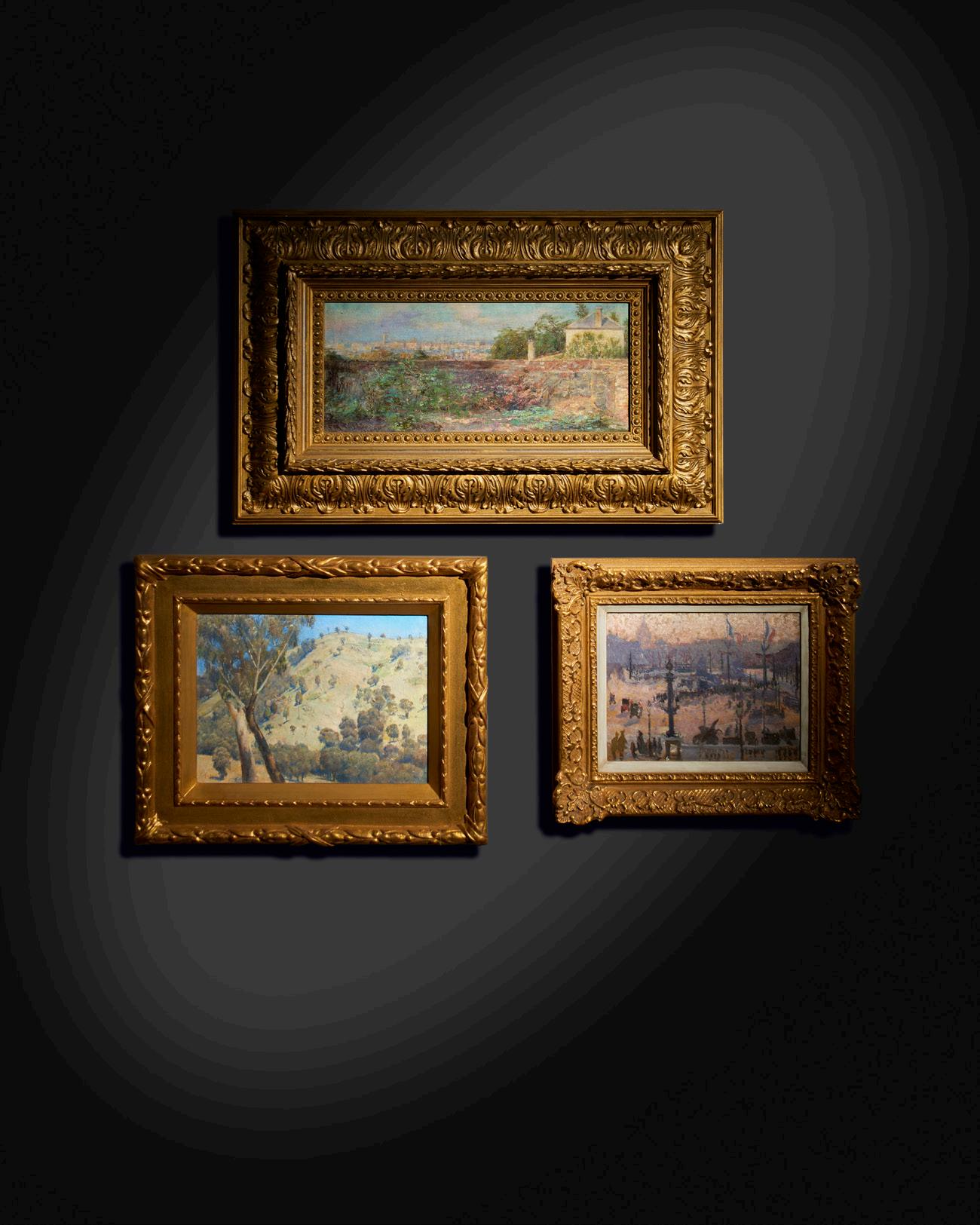
Important Collections
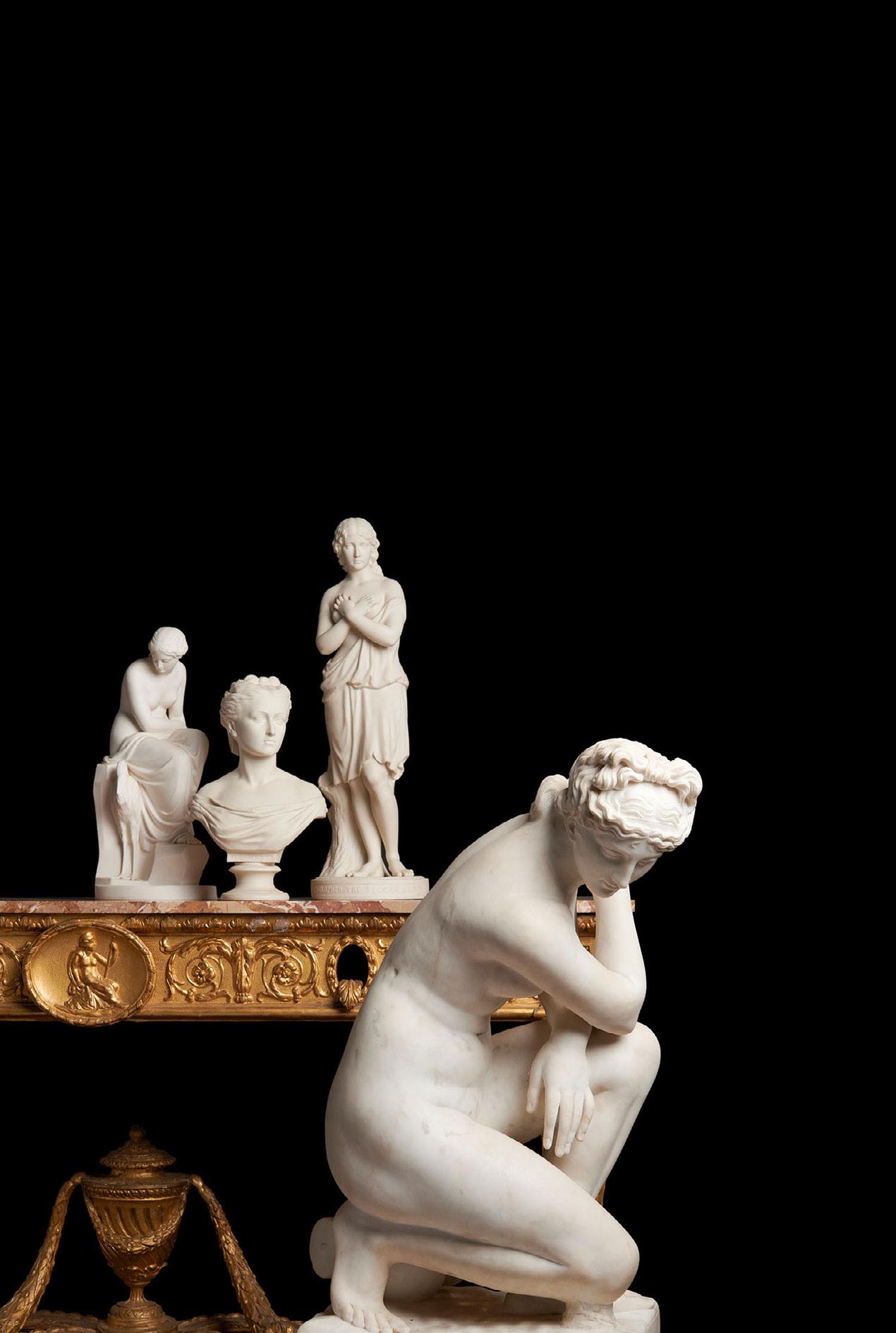
Established in 1919, Leonard Joel remains the auctioneer of choice for the management and celebration of important single-owner collections. leonardjoel.com.au
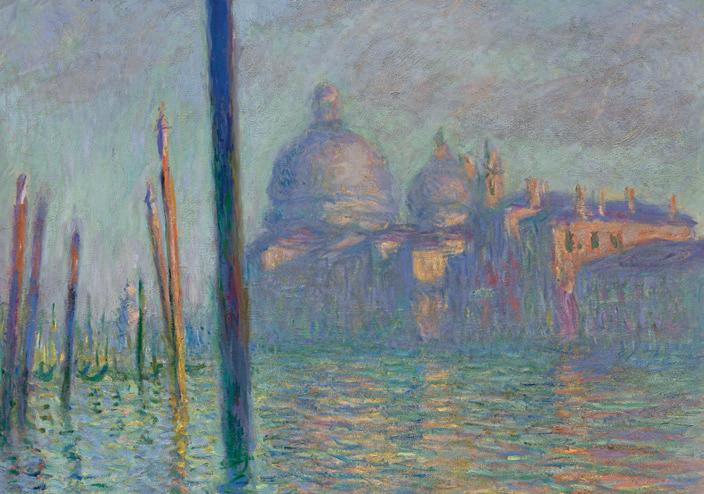


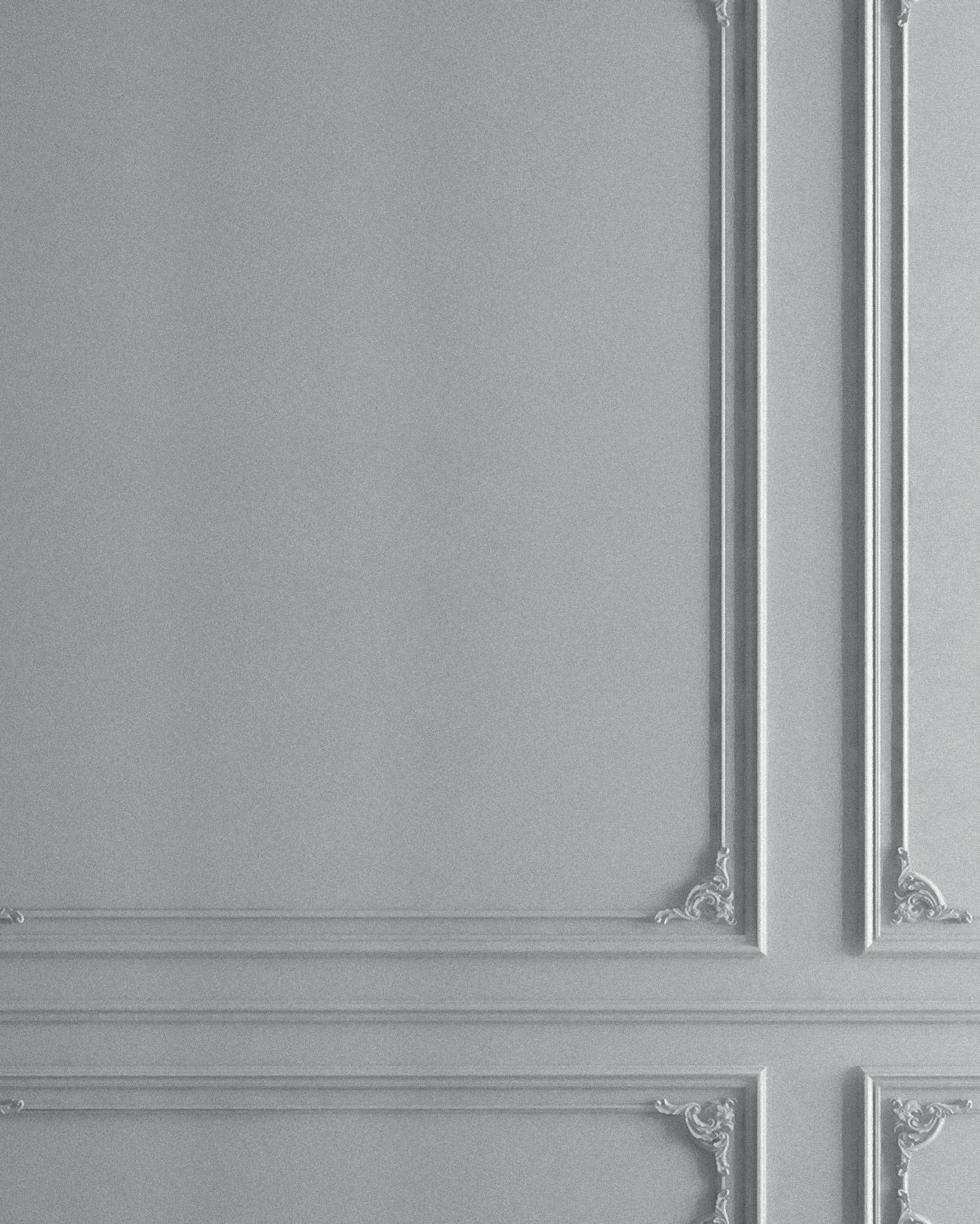
Conditions of Business / Summary
special conditions of sale – Jewellery
Jewellery and watches offered by Leonard Joel are sometimes accompanied by an Independent valuation as stated in the catalogue. These valuations are conducted by registered valuers and are offered purely as independent opinions. Variation may be found as to the colour, clarity and size of stones described in these reports, consequently Leonard Joel does not guarantee these Independent Valuations. Where stones can be weighed accurately, weights will be provided. Weights of set stones are estimates only and are provided to the best of our technical ability. Gram weight on gold and other precious metals are also given as an approximation. Wristwatches and pocket watches are offered in there current condition and Leonard Joel does not guarantee that they are in working order. Items may be thoroughly inspected during the viewing period or by prior arrangement.
authenticity certificates
As various manufacturers may not issue certificates of authenticity, Leonard Joel has no obligation to furnish a buyer with a certificate of authenticity from the manufacturer, except where specifically noted in the catalogue. Unless Leonard Joel is satisfied that it should cancel the sale in accordance with the Limited Warranty provided in the General Conditions of Business, the failure of a manufacturer to issue a certificate will not constitute grounds for cancellation of the sale.
gst
In the event that the vendor is registered for Goods & Services Tax (GST), the invoice to the buyer will provide a separate entry for the GST which is included in the purchase price. All Leonard Joel charges for services referred to in this catalogue are exclusive of GST. Overseas buyers may be entitled to a rebate for GST charged.
For further information contact: Ety Liong accounts@leonardjoel.com.au
admission
Leonard Joel has the right at its sole discretion without assigning any reason therefore to refuse admission to the premises or attendance at any of its sales of any person.
commission (absentee) bids
Leonard Joel will execute absentee bids when instructed. Lots will be bought as cheaply as allowed by other bids and/or reserves.
telephone bidding
Buyers interested in bidding by telephone should contact Leonard Joel as soon as possible. Please note that telephone bidding facilities are available on a first-come, first-served basis.
bidder registration
To recognise bidders during the sale all intending buyers are required to complete a Bidder Registration Form providing full photo identification and appropriate references if required before the Sale which will enable them to bid by way of a numbered paddle allocated to them.
buyer’s premium
There will be a buyer’s premium added to all purchases.The buyer’s premium will be calculated at the rate of 25% of the hammer price on each lot. This is inclusive of GST. The buyer’s premium is reflected by a reduction in the Seller’s Commission and is a common practice throughout Australia and overseas.
property subJect to the artist resale royalty Lots with the § sign will be subject to payment of the Artist Resale Royalty in the event that the lot is sold for a hammer price of $1,000 or more. The Australian Resale Royalty is a flat rate of 5 percent (5%) levy on the hammer price (including GST). The Australian Resale Royalty is payable by the buyer in addition to the buyer’s premium plus applicable GST.
damage
Any viewer who damages a Lot will be held liable for all damage caused and shall reimburse Leonard Joel for all costs and expenses relating to rectification of such damage.
title
Leonard Joel guarantees good title to all lots.
warranties and condition reports
Condition reports will be available for any lot upon request, subject to conditions.
estimates
Estimates are a reflection of Leonard Joel’s opinion of the current market values, based on historic and current market realisations of similar lots. Estimates are inclusive of any GST, which may be applicable. Actual prices at this sale may fall short or exceed the estimates.
payment
In any event accounts must be settled with Leonard Joel no later than 4pm two days after the auction. Attention is specifically drawn to condition 22 of the Buyer’s Conditions of Sale.
Payment may be made by way of cheque, most credit cards, eftpos or telegraphic transfer.
Please note: payments made by cheque are subject to a 5 day clearance before goods can be collected.
Credit card fees may apply.
Bank telegraph transfers should be directed to:
account name: Leonard Joel Pty Ltd
address: Westpac Banking Corporation
150 Collins Street, Melbourne
VIC 3000 Australia
bsb: 033–364
account no: 942956
collection of lots
Purchased lots must be collected no later than two days after the auction; otherwise lots shall be moved to storage at the Buyer’s expense (see below). Lots are at the Buyer’s risk from the fall of the hammer. It is strongly advised that overseas and interstate purchasers and absentee bidders make their arrangements with Leonard Joel in advance of the Sale. Charges are outlined below and are quoted in Australian dollars.
removal and storage
Any lots not collected within two days after the auction, may be stored or resold at the Buyer’s expense.
removal charges
Each lot: $55
storage charges
Each lot: $33 per day
protection of movable cultural heritage act 1986 (pmch act)
Buyers should be aware of the PMCH Act which protects Australia’s heritage of movable cultural objects and supports foreign countries’ right to protect their heritage of movable cultural objects. The PMCH Act regulates the export of nationally significant heritage objects, it is not intended to restrict normal and legitimate trade in cultural property, and does not affect an individual’s right to own or sell objects, within Australia. The PMCH Act was enacted in response to the 1970 UNESCO Convention on the Means of Prohibiting the Illicit Import, Export and Transfer of Ownership of Cultural Property. It is the responsibility of the Buyer to ensure that the export of any lots purchased are not subject to, or in breach of, this Act.
Information about the PMCH Act, the Protection of Movable Cultural Heritage Regulations 1987 and the 1970 UNESCO Convention, can be found on the Department of the Environment, Water, Heritage and the Arts website at: www.environment.gov.au/heritage/movable/index
exporting significant australian cultural heritage
The export of Australia’s significant cultural heritage is regulated under the Protection of Movable Cultural Heritage Act 1986 (PMCH Act.) It is not intended to restrict normal and legitimate trade in cultural property and does not affect an individual’s right to own or sell within Australia. The PMCH Act implements a system of export permits for certain heritage objects defined as ‘Australian protected objects’. More information is available on the Department of the Environment, Water Heritage and the Arts’ website: www.arts.gov.au/movable_heritage Enquiries can be made to the Cultural Property Section at the Department of the Environment, Water, Heritage and the Arts, T: 02 6274 1810 E: movable.heritage@environment.gov.au
cites regulations
It is the buyer’s sole responsibility to comply with all export and import regulations relating to your purchases and also to obtain any relevant export and/or import licences. The refusal of any import or export licences, any delay in obtaining such licences or any limitation on your ability to export a lot shall not permit the cancellation of the sale. Please note that all lots marked with the symbol * are subject to CITES regulations when exporting these items outside of Australia. Information about these regulations may be found at www.environment.gov.au/biodiversity/tradeuse/cites/index.html or may be requested from:
The Director International Wildlife Trade Department of Sustainability, Environment, Water, Population and Communities
GPO Box 787
CANBERRA ACT 2601
leonard home delivery
Purchases can be delivered to your door via Leonard Home Delivery. Please note this service is available in Melbourne (Select suburbs) only and is not available for Sydney auction purchases. For any enquiries about this service please contact delivery@ leonardjoel.com.au
recommended carriers
For recommended carriers please refer to our website.
This document has been produced to international environmental management standard ISO14001 by Ellikon Fine Printers, a certified green printing company.
Our Specialists
m anaging d irector & head of important collections
John Albrecht, BA LLB MBA
fine art
Wiebke Brix, Head of Art
Amanda North, Senior Art Specialist
Hannah Ryan, Senior Art Specialist, Manager of Specialty Auctions
Charlotte Barrett, Administrator and Registrar
decorative arts
Chiara Curcio BA, Head of Department
David Parsons, Head of Private Estates and Valuations, Decorative Arts Specialist
asian art
Luke Guan MLitt, Head of Department
sydney
Ronan Sulich, Senior Adviser
Madeleine Mackenzie BFA, BComm, MLitt, Head of Decorative Arts & Art
Ella Nail, Office Manager & Administrator
important J ewels
Hamish Sharma, Head of Department, Sydney
fine J ewels & timepieces
Bethany McGougan, Head of Department, Melbourne
Patricia Kontos F.G.A.A., Senior Jewellery Specialist
Lauren Boustridge BSc, AJP, GG (GIA), Senior Specialist, Sydney
Phoebe East, Jewellery Assistant
Echo Liu, Jewellery & Luxury Administrator
John D'Agata, Senior Jewellery Consultant
Henrietta Maiyah, Consultant
modern design
Rebecca Stormont, Specialist
Maya Loughnan, Assistant
luxury
Julia Gueller, Specialist
prints
Hannah Ryan, Senior Art Specialist
furniture
Natasha Berlizova, Manager
Angus McGougan, Assistant
Alex Sargeant, Assistant
Inigo Fleming, Assistant
Shawn Mitchell , Interiors Consultant
J ewellery
Phoebe East, Manager
Anna Akacich, Assistant
art salon
Millie Lewis, Manager
Jane Goh, Assistant
ob J ects & collectables
Dominic Kavanagh MFA, Manager
Kieran Grogan Carpenter, Assistant
valuations
David Parsons, Head of Private Estates and Valuations, Decorative Arts Specialist
Troy McKenzie, Principal Specialist, Queensland
Anthony Hurl, Representative Specialist, South Australia
John Brans, Representative Specialist, Western Australia
accounts
Ety Liong, Finance Manager
Michelle Draper, Accounts Manager
Ninad Chouhan , Finance & Accounts Assistant
client services
Kim Clarke, Saleroom & Office Manager
Amelia Lewis, Client Services Liaison
Richard Grieve, Client Services Liaison
Kyle Walker, Client Services Liaison
operations & logistics
David Price, Operations, Delivery & Logistics Manager
Nathan Cooper, Delivery & Logistics Assistant
marketing & communications
Lucy Lewis, Marketing, Media, & Communications Manager
Kyle Walker, Marketing & Database Coordinator
photography
Paolo Cappelli, Senior Photographer & Videographer
Adam Obradovic, Photographer & Videographer
graphic design
Maria Rossi
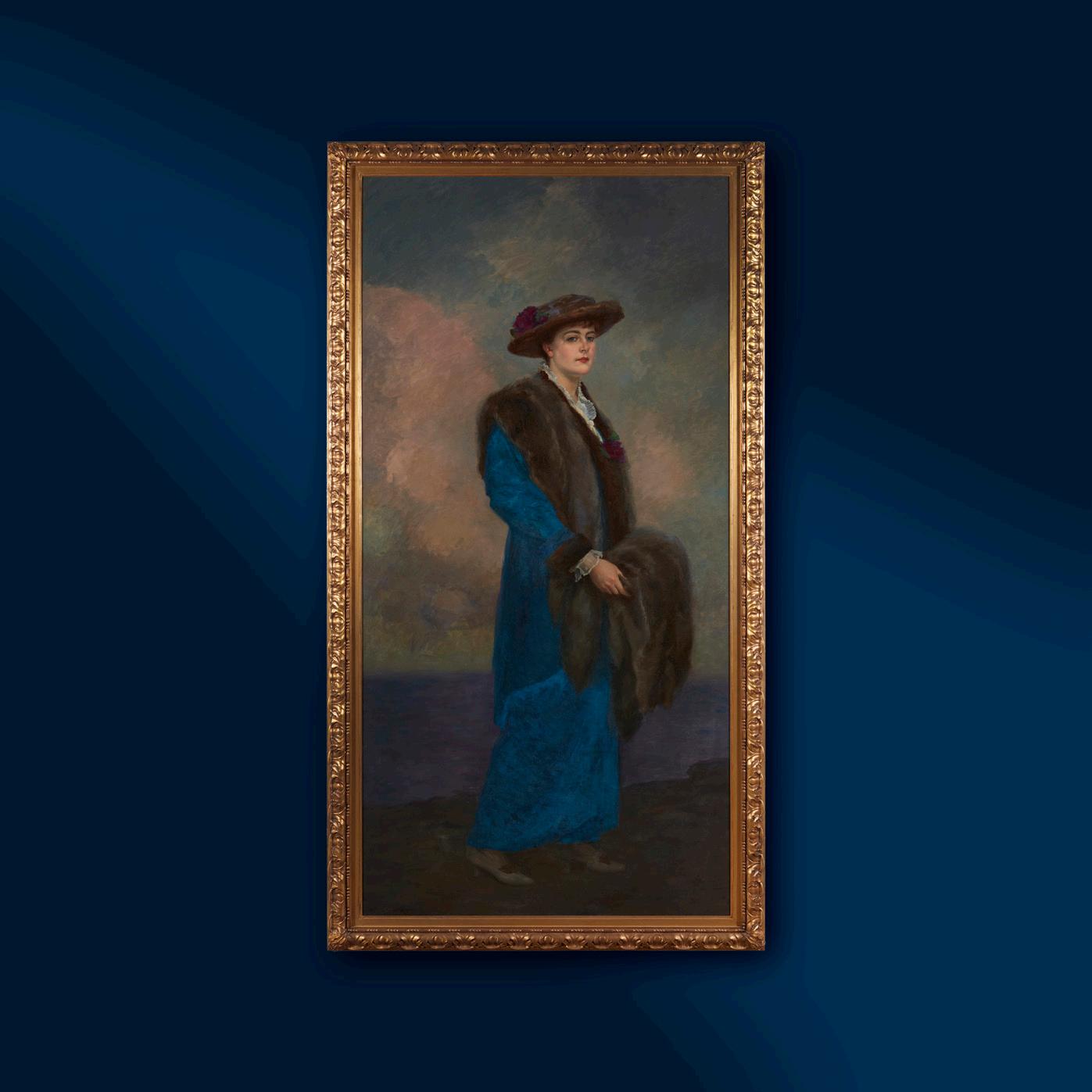

melbourne 2 Oxley Road, Hawthorn, VIC 3122 (03) 9826 4333
sydney
The Bond, 36-40 Queen Street, Woollahra, NSW 2025 (02) 9362 9045
brisbane 54 Vernon Terrace, Teneriffe, QLD 4005 0412 997 080
adelaide 429 Pulteney Street, Adelaide SA 5000 0419 838 841
perth 0412 385 555
info@leonardjoel.com.au leonardjoel.com.au
